Zeolites Enhance Soil Health, Crop Productivity and Environmental Safety
Abstract
1. Introduction
2. Origin, Structure and Properties of Zeolites
3. Impacts of Zeolite Application in Agriculture
3.1. Improvement of Soil Physical Properties
3.2. Nutrient Retention
3.3. Environmental Impact
3.4. Slow Release of Herbicides
3.5. Remediation of Contaminated Soil
3.6. Wastewater Treatment
3.7. Crop Management Practices
3.8. Used as a Pesticide
3.9. Mycotoxin Control
4. Limitation of Zeolites
5. Future Scope
6. Conclusions
Author Contributions
Funding
Conflicts of Interest
References
- Alexandratos, N.; Bruinsma, J. World Agriculture Towards 2030/2050. Food and Agriculture Organization of the United Nations. 2012. Available online: www.fao.org/economic/esa (accessed on 10 February 2021).
- Bhatt, R.; Singh, P.; Hossain, A.; Timsina, J. Rice–wheat system in the northwest Indo-Gangetic plains of South Asia: Issues and technological interventions for increasing productivity and sustainability. Paddy Water Environ. 2021, 1–21. [Google Scholar] [CrossRef]
- Xiubin, H. and Zhanbin, H. Zeolite application for enhancing water infiltration and retention in loess soil. Resour. Conserv. Recycl. 2001, 34, 45–52. [Google Scholar] [CrossRef]
- Wu, Q.; Chi, D.; Xia, G.; Chen, T.; Sun, Y.; Song, Y. Effects of Zeolite on Drought Resistance and Water–Nitrogen Use Efficiency in Paddy Rice. J. Irrig. Drain. Eng. 2019, 145, 04019024. [Google Scholar] [CrossRef]
- Garai, S.; Mondal, M.; Mukherjee, S. Smart Practices and Adaptive Technologies for Climate Resilient Agriculture. In Advanced Agriculture, 1st ed.; Maitra, S., Pramanick, B., Eds.; New Delhi Publishers: Kolkata, India, 2020; pp. 327–358. [Google Scholar]
- Ming, D.W.; Mumpton, F.A. Zeolites in soils. Miner. Soil Environ. 1989, 1, 873–911. [Google Scholar] [CrossRef]
- Peña-Haro, S.; Llopis-Albert, C.; Pulido-Velazquez, M.; Pulido-Velazquez, D. Fertilizer standards for controlling groundwater nitrate pollution from agriculture: El Salobral-Los Llanos case study, Spain. J. Hydrol. 2010, 392, 174–187. [Google Scholar] [CrossRef]
- Hosono, T.; Tokunaga, T.; Kagabu, M.; Nakata, H.; Orishikida, T.; Lin, I.; Shimada, J. The use of δ 15 N and δ 18 O tracers with an understanding of groundwater flow dynamics for evaluating the origins and attenuation mechanisms of nitrate pollution. Water Res. 2013, 47, 2661–2675. [Google Scholar] [CrossRef] [PubMed]
- Aschebrook-Kilfoy, B.; Shu, X.; Gao, Y.; Ji, B.; Yang, G.; Li, H.L.; Rothman, N.; Chow, W.; Zheng, W.; Ward, M.H. Thyroid cancer risk and dietary nitrate and nitrite intake in the Shanghai women’s health study. Int. J. Cancer 2013, 132, 897–904. [Google Scholar] [CrossRef]
- Mondal, M.; Garai, S.; Banerjee, H.; Sarkar, S.; Kundu, R. Mulching and nitrogen management in peanut cultivation: An evaluation of productivity, energy trade-off, carbon footprint and profitability. Energy Ecol. Environ. 2020. [Google Scholar] [CrossRef]
- Delkash, M.; Al-Faraj, F.A.; Scholz, M. Comparing the export coefficient approach with the soil and water assessment tool to predict phosphorous pollution: The Kan watershed case study. Water Air Soil Pollut. 2014, 225, 1–17. [Google Scholar] [CrossRef]
- Bakhshayesh, B.E.; Delkash, M.; Scholz, M. Response of vegetables to cadmium-enriched soil. Water 2014, 6, 1246–1256. [Google Scholar] [CrossRef]
- Nakhli, S.A.; Ahmadizadeh, K.; Fereshtehnejad, M.; Rostami, M.H.; Safari, M.; Borghei, S.M. Biological removal of phenol from saline wastewater using a moving bed biofilm reactor containing acclimated mixed consortia. SpringerPlus 2014, 3, 112. [Google Scholar] [CrossRef]
- Leggo, P.J. The efficacy of the organo-zeolitic bio-fertilizer. Agrotechnology 2015, 4, 1000130. [Google Scholar] [CrossRef]
- Mahabadi, A.A.; Hajabbasi, M.; Khademi, H.; Kazemian, H. Soil cadmium stabilization using an Iranian natural zeolite. Geoderma 2007, 137, 388–393. [Google Scholar] [CrossRef]
- Al-Busaidi, A.; Yamamoto, T.; Inoue, M.; Eneji, A.E.; Mori, Y.; Irshad, M. Effects of zeolite on soil nutrients and growth of barley following irrigation with saline water. J. Plant. Nutr. 2008, 31, 1159–1173. [Google Scholar] [CrossRef]
- Sarkar, B.; Naidu, R. Nutrient and water use efficiency in soil: The influence of geological mineral amendments. In Nutrient Use Efficiency: From Basics to Advances; Rakshit, A., Singh, H.B., Sen, A., Eds.; Springer: New Delhi, India, 2015; pp. 29–44. [Google Scholar]
- Jha, B.; Singh, D.N. Fly Ash Zeolites: Innovations, Applications, and Directions; Springer: Singapore, 2016; pp. 33–51. [Google Scholar]
- Virta, R.L. Zeolites. In Us Geological Survey Minerals Yearbook; US Geological Survey: Reston, VA, USA, 2002; pp. 84.1–84.4. [Google Scholar]
- Elliot, A.D.; Zhang, D. Controlled release zeolite fertilisers: A value-added product produced from fly ash. Bioprocess. Technol 2005, 4, 39–47. [Google Scholar]
- Ober, J.A. Mineral commodity summaries. US Geol. Surv. 2017, 202. [Google Scholar] [CrossRef]
- Inglezakis, V.; Elaiopoulos, K.; Aggelatou, V.; Zorpas, A.A. Treatment of underground water in open flow and closed—loop fixed bed systems by utilizing the natural minerals clinoptilolite and vermiculite. Desalination Water Treat. 2012, 39, 215–227. [Google Scholar] [CrossRef]
- Talebnezhad, R.; Sepaskhah, A.R. Effects of bentonite on water infiltration in a loamy sand soil. Arch. Agron. Soil Sci. 2013, 59, 1409–1418. [Google Scholar] [CrossRef]
- Chmielewska, E. Zeolitic adsorption in course of pollutants mitigation and environmental control. J. Radioanal. Nucl. Chem. 2014, 299, 255–260. [Google Scholar] [CrossRef]
- Ebrazi, B.; Banihabib, M.E. Simulation of Ca2+ and Mg2+ removal process in fixed-bed column of natural zeolite. Desalination Water Treat. 2015, 55, 1116–1124. [Google Scholar] [CrossRef]
- Enamorado-Horrutiner, Y.; Villanueva-Tagle, M.; Behar, M.; Rodríguez-Fuentes, G.; Dias, J.F.; Pomares-Alfonso, M. Cuban zeolite for lead sorption: Application for water decontamination and metal quantification in water using nondestructive techniques. Int. J. Environ. Sci. Technol. 2016, 13, 1245–1256. [Google Scholar] [CrossRef]
- Perez-Caballero, R.; Gil, J.; Benitez, C.; Gonzalez, J.L. The effect of adding zeolite to soils in order to improve the N-K nutrition of olive trees, preliminary results. Am. J. Agric. Biol. Sci. 2008, 2, 321–324. [Google Scholar]
- Shahsavari, N.; Jais, H.M.; Shirani Rad, A.H. Responses of canola oil quality characteristics and fatty acid composition to zeolite and zinc fertilization under drought stress. Int. J. Agric. Sci. 2014, 4, 49–59. [Google Scholar]
- Chen, T.; Guimin, X.; Qi, W.; Zheng, J.; Jin, Y.; Sun, D.; Wang, S.; Chi, D. The Influence of Zeolite Amendment on Yield Performance, Quality Characteristics, and Nitrogen Use Efficiency of Paddy Rice. Crop. Sci. 2017, 57, 1–11. [Google Scholar] [CrossRef]
- Ghanbari, M.; Ariafar, S. The effect of water deficit and zeolite application on Growth Traits and Oil Yield of Medicinal Peppermint (Mentha piperita L.). Int. J. Med. Arom. Plants 2013, 3, 33–39. [Google Scholar]
- Aainaa, H.N.; Ahmed, O.H.; Majid, N.M.A. Effects of clinoptilolite zeolite on phosphorus dynamics and yield of Zea Mays L. cultivated on an acid soil. PLoS ONE 2018, 13, e0204401. [Google Scholar] [CrossRef]
- Zheng, J.; Chen, T.; Wu, Q.; Yu, J.; Chen, W.; Chen, Y. Effect of zeolite application on phenology, grain yield and grain quality in rice under water stress. Agric. Water Manag. 2018, 206, 241–251. [Google Scholar] [CrossRef]
- Hazrati, S.; Tahmasebi-Sarvestani, Z.; Mokhtassi-Bidgoli, A.; Modarres-Sanavy, S.A.M.; Mohammadi, H.; Nicola, S. Effects of zeolite and water stress on growth, yield and chemical compositions of Aloe vera L. Agric. Water Manag. 2017, 181, 66–72. [Google Scholar] [CrossRef]
- Kazemian, H.; Mallah, M.H. Elimination of Cd2 and Mn2 from wastewaters using natural clinoptilolite and synthetic zeolite P. Iran. J. Chem. Chem. Eng. 2006, 25, 91–94. [Google Scholar]
- Kazemian, H.; Mallah, M. Removal of chromate ion from contaminated synthetic water using MCM-41/ZSM-5 composite. J. Environ. Health Sci. Eng. 2008, 5, 73–77. [Google Scholar]
- Youssefi, S.; Waring, M.S. Indoor transient SOA formation from ozone α-pinene reactions: Impacts of air exchange and initial product concentrations, and comparison to limonene ozonolysis. Atmos. Environ. 2015, 112, 106–115. [Google Scholar] [CrossRef]
- Scopus Preview. Available online: https://www.scopus.com/home.uri (accessed on 7 November 2020).
- Polat, E.; Karaca, M.; Demir, H.; Naci-Onus, A. Use of natural zeolite (clinoptilolite) in agriculture. J. Fruit Ornam. Plant. Res. 2004, 12, 183–189. [Google Scholar]
- USGS. Mineral Commodity Summaries: Zeolites (Natural). 2016. Available online: http://minerals.usgs.gov/minerals/pubs/commodity/zeolites/index.html (accessed on 31 December 2020).
- Bhattacharyya, T.; Chandran, P.; Ray, S.K.; Pal, D.K.; Mandal, C.; Mandal, D.K. Distribution of zeolitic soils in India. Curr. Sci. 2015, 109, 1305–1313. [Google Scholar] [CrossRef]
- Nakhli, S.A.A.; Delkash, M.; Bakhshayesh, B.E.; Kazemian, H. Application of Zeolites for Sustainable Agriculture: A Review on Water and Nutrient Retention. Water Air. Soil Pollut. 2017, 228, 464. [Google Scholar] [CrossRef]
- Sangeetha, C.; Baskar, P. Zeolite and its potential uses in agriculture: A critical review. Agric. Rev. 2016, 37, 101–108. [Google Scholar] [CrossRef]
- International Zeolite Association. Available online: http://www.iza-online.org (accessed on 7 November 2020).
- Hemingway, B.S.; Robie, R.A. Thermodynamic properties of zeolites: Low-temperature heat capacities and thermodynamic functions for phillipsite and clinoptilolite. Estimates of the thermo-chemical properties of zeolitic water at low temperature. Am. Miner. 1984, 69, 692–700. [Google Scholar]
- Chmielewska, E.; Lesný, J. Selective ion exchange onto Slovakian natural zeolites in aqueous solutions. J. Radioanal. Nucl. Chem. 2012, 293, 535–543. [Google Scholar] [CrossRef]
- Stylianou, M.; Inglezakis, V.; Loizidou, M. Comparison of Mn, Zn, and Cr removal in fluidized-and fixed-bed reactors by using clinoptilolite. Desalination Water Treat. 2015, 53, 3355–3362. [Google Scholar] [CrossRef]
- Flanigen, E.M. Introduction to Zeolite Science and Practice; Elsevier: Amsterdam, The Netherlands, 2001; pp. 11–35. [Google Scholar]
- Bittelli, M.; Campbell, G.S.; Tomei, F. Soil Physics with Python: Transport in the Soil-Plant. Atmosphere System; OUP: Oxford, UK, 2015. [Google Scholar] [CrossRef]
- Ramesh, K.; Reddy, D.D.; Biswas, A.K.; Subbarao, A. Potential uses of zeolite in agriculture. Adv. Agron. 2011, 113, 215–236. [Google Scholar]
- Torkashvand, A.M.; Shadparvar, V. Effect of some organic waste and zeolite on water holding capacity and PWP delay of soil. Curr. Biot. 2013, 6, 459–465. [Google Scholar]
- Valadabadi, S.A.; Shiranirad, A.H.; Farahani, H.A. Ecophysiological influences of zeolite and selenium on water deficit stress tolerance in different rapeseed cultivars. J. Ecol. Nat. Environ. 2010, 2, 154–159. [Google Scholar]
- Colombani, N.; Mastrocicco, M.; Di Giuseppe, D.; Faccini, B.; Coltorti, M. Variation of the hydraulic properties and solute transport mechanisms in a silty-clay soil amended with natural zeolites. Catena 2014, 123, 195–204. [Google Scholar] [CrossRef]
- Gholamhoseini, M.; Ghalavand, A.; Khodaei-Joghan, A.; Dolatabadian, A.; Zakikhani, H.; Farmanbar, E. Zeolite amended cattle manure effects on sunflower yield, seed quality, water use efficiency and nutrient leaching. Soil Tillage Res. 2013, 126, 193–202. [Google Scholar] [CrossRef]
- Bernardi, A.C.C.; Oliveria, P.P.A.; Barros, F. Brazilian sedimentary zeolite use in agriculture. Microporous Mesoporous Mater. 2013, 17, 16–21. [Google Scholar] [CrossRef]
- Ghazavi, R. The application effects of natural zeolite on soil runoff, soil drainage and some chemical soil properties in arid land area. Int. J. Innov. Appl. Stud. 2015, 13, 172–177. [Google Scholar]
- Aminiyan, M.M.; Sinegani, A.A.S.; Sheklabadi, M. Aggregation stability and organic carbon fraction in a soil amended with some plant residues, nanozeolite, and natural zeolite. Int. J. Recycl. Org. Waste Agric. 2015, 4, 11–22. [Google Scholar] [CrossRef]
- Moritani, S.; Yamamoto, T.; Andry, H.; Inoue, M.; Yuya, A.; Kaneuchi, T. Effectiveness of artificial zeolite amendment in improving the physicochemical properties of saline-sodic soils characterised by different clay mineralogies. Aust. J. Soil Res. 2010, 48, 470–479. [Google Scholar] [CrossRef]
- Cairo, P.C.; De Armas, J.M.; Artiles, P.T.; Martin, B.D.; Carrazana, R.J.; Lopez, O.R. Effects of zeolite and organic fertilizers on soil quality and yield of sugarcane. Aust. J. Crop. Sci. 2017, 11, 733–738. [Google Scholar] [CrossRef]
- Sepaskhah, A.R.; Yousefi, F. Effects of zeolite application on nitrate and ammonium retention of a loamy soil under saturated conditions. Aust. J. Soil Res. 2007, 45, 368–373. [Google Scholar] [CrossRef]
- Gholizadeh-Sarabi, S.; Sepaskhah, A.R. Effect of zeolite and saline water application on saturated hydraulic conductivity and infiltration in different soil textures. Arch. Agron. Soil Sci. 2013, 59, 753–764. [Google Scholar] [CrossRef]
- Razmi, Z.; Sepaskhah, A.R. Effect of zeolite on saturated hydraulic conductivity and crack behavior of silty clay paddled soil. Arch. Agron. Soil Sci. 2012, 58, 805–816. [Google Scholar] [CrossRef]
- Githinji, L.J.; Dane, J.H.; Walker, R.H. Physical and hydraulic properties of inorganic amendments and modeling their effects on water movement in sand-based root zones. Irrig. Sci. 2011, 29, 65–77. [Google Scholar] [CrossRef]
- Aiyuk, S.; Xu, H.; Van Haandel, A. Removal of ammonium nitrogen from pretreated domestic sewage using a natural ion exchanger. Environ. Technol. 2004, 25, 1321–1330. [Google Scholar] [CrossRef]
- Englert, A.; Rubio, J. Characterization and environmental application of a Chilean natural zeolite. Int. J. Min. Process. 2005, 75, 21–29. [Google Scholar] [CrossRef]
- Sprynskyy, M.; Lebedynets, M.; Terzyk, A.P.; Kowalczyk, P.; Namieśnik, J.; Buszewski, B. Ammonium sorption from aqueous solutions by the natural zeolite Transcarpathian clinoptilolite studied under dynamic conditions. J. Colloid Interface Sci. 2005, 284, 408–415. [Google Scholar] [CrossRef] [PubMed]
- Zabochnicka-Swiatek, M. Factors Affecting Adsorption Capacity and Ion Exchange Selectivity of Clinoptilolite towards heavy metal cations. Inz. I Ochr. 2007, 10, 27. [Google Scholar]
- Jha, V.K.; Hayashi, S. Modification on natural clinoptilolite zeolite for its NH4+ retention capacity. J. Hazard. Mater. 2009, 169, 29–35. [Google Scholar] [CrossRef] [PubMed]
- Mazloomi, F.; Jalali, M. Ammonium removal from aqueous solutions by natural Iranian zeolite in the presence of organic acids, cations and anions. J. Environ. Chem. Eng. 2016, 4, 240–249. [Google Scholar] [CrossRef]
- Gorre, K.; Yenumula, S.; Himabindu, V.A. Study on the Ammonium Adsorption by using Natural Heulandite and Salt Activated Heulandite. Int. J. Innov. Appl. Stud. 2016, 14, 483–488. [Google Scholar]
- Shaikh, I.I.; Chendaku, Y.J. Removal of ammonium nitrate from aquaculture by sorption using zeolite. Int. J. Recent Sci. Res. 2016, 7, 11869–11874. [Google Scholar]
- Liang, Z.; Ni, J. Improving the ammonium ion uptake onto natural zeolite by using an integrated modification process. J. Hazard. Mater. 2008, 166, 52–60. [Google Scholar] [CrossRef]
- Aghaalikhani, M.; Gholamhoseini, M.; Dolatabadian, A.; Khodaei-Joghan, A.; Sadat, A.K. Zeolite influences on nitrate leaching, nitrogen-use efficiency, yield and yield components of canola in sandy soil. Arch. Agron. Soil Sci. 2012, 58, 1149–1169. [Google Scholar] [CrossRef]
- Vilcek, J.; Torma, S.; Adamisin, P.; Hronec, O. Nitrogen sorption and its release in the soil after zeolite application. Bulg. J. Agric. Sci. 2013, 9, 228–234. [Google Scholar]
- Omar, L.; Ahmed, O.H.; Majid, N.M.A. Improving Ammonium and Nitrate release from Urea using Clinoptilolite zeolite and compost produced from agricultural wastes. Sci. World J. 2015, 574201, 1–12. [Google Scholar] [CrossRef]
- Haruna, A.O.; Husin, A.; Husni, M.H.A. Ammonia volatilization and ammonium accumulation from urea mixed with zeolite and triple superphosphate. Acta Agric. Scand B Soil Plant. Sci. 2008, 58, 182–186. [Google Scholar] [CrossRef]
- Yore, N.; Kalpana, I.; Saya, T. Reducing ammonia volatile concentration from compound fertilizers modified with zeolite. Int. J. Manures Fert. 2013, 2, 352–354. [Google Scholar]
- Rech, I.; Polidoro, J.C.; Pavinato, P.S. Additives incorporated into urea to reduce nitrogen losses after application to the soil. Pesq. Agropec. Bras. 2017, 52, 194–204. [Google Scholar] [CrossRef]
- Zaman, M.; Nguyen, M.L.; Šimek, M.; Nawaz, S.; Khan, M.J.; Babar, M.N.; Zaman, S. Emissions of nitrous oxide (N2O) and di-nitrogen (N2) from the agricultural landscapes, sources, sinks, and factors affecting N2O and N2 ratios. In Greenhouse Gases-Emission, Measurement and Management; Liu, G., Ed.; InTech Europe: Rijeka, Croatia, 2012; published online 14, March, 2012, published in print edition March, 2012; pp. 1–32. [Google Scholar]
- Li, J.; Wee, C.; Sohn, B. Effect of Ammonium- and Potassium-Loaded Zeolite on Kale, Growth and Soil Property. Amer. J. Plant. Sci. 2013, 4, 1976–1982. [Google Scholar] [CrossRef]
- Behzadfar, M.; Sadeghi, S.H.; Khanjani, M.J.; Hazbavi, Z. Effects of rates and time of zeolite application on controlling runoff generation and soil loss from a soil subjected to a freeze-thaw cycle. Int. Soil Water Conserv. Res. 2017, 5, 95–101. [Google Scholar] [CrossRef]
- Ahmed, O.; Aminuddin, H.; Husni, M. Reducing ammonia loss from urea and improving soil exchangeable ammonium retention through mixing triple super-phosphate, humic acid and zeolite. Soil Use Manag. 2006, 22, 315–319. [Google Scholar] [CrossRef]
- Palanivell, P.; Ahmed, O.H.; Ab Majid, N.M. Minimizing ammonia volatilization from urea, improving lowland rice (cv. MR219) seed germination, plant growth variables, nutrient uptake, and nutrient recovery using clinoptilolite zeolite. Arch. Agron. Soil Sci. 2016, 62, 708–724. [Google Scholar] [CrossRef]
- Omar, O.L.; Ahmed, O.H.; Muhamad, A.N. Minimizing ammonia volatilization in waterlogged soils through mixing of urea with zeolite and sago waste water. Int. J. Phys. Sci. 2010, 5, 2193–2197. [Google Scholar]
- Manikandan, A.; Subramanian, K.S. Fabrication and characterisation of nanoporouszeolite based N fertilizer. Afr. J. Agric. Res. 2014, 9, 276–284. [Google Scholar]
- Ramesh, K.; Biswas, A.K.; Somasundaram, J.; Subbarao, A. Nanoporous zeolites in farming: Current status and issues ahead. Curr. Sci. 2010, 99, 760–765. [Google Scholar]
- Ge, J.; Wu, R.; Shi, X.H.; Yu, H.; Wang, M.; Wen, L. Biodegradable polyurethane materials from bark and starch. II. Coating materials for controlled release fertilizer. J. Appl. Polym. Sci. 2002, 86, 2948–2952. [Google Scholar] [CrossRef]
- Huang, Z.T.; Petrovic, A.M. Physical properties of sand as affected by clinoptilolite zeolite particle size and quantity. J. Turfgrass Manag. 1994, 1, 1–15. [Google Scholar] [CrossRef]
- Zwingmann, N.; Singh, B.; Mackinnon, I.D.; Gilkes, R.J. Zeolite from alkali modified kaolin increases NH 4 retention by sandy soil: Column experiments. Appl. Clay Sci. 2009, 46, 7–12. [Google Scholar] [CrossRef]
- MacKown, C.; Tucker, T. Ammonium nitrogen movement in a coarse-textured soil amended with zeolite. Soil Sci. Soc. Am. J. 1985, 49, 235–238. [Google Scholar] [CrossRef]
- Gholamhoseini, M.; AghaAlikhani, M.; Dolatabadian, A.; Khodaei-Joghan, A.; Zakikhani, H. Decreasing nitrogen leaching and increasing canola forage yield in a sandy soil by application of natural zeolite. Agron. J. 2012, 104, 1467–1475. [Google Scholar] [CrossRef]
- Taheri-Sodejani, H.; Ghobadinia, M.; Tabatabaei, S.; Kazemian, H. Using natural zeolite for contamination reduction of agricultural soil irrigated with treated urban wastewater. Desalin. Water Treat. 2015, 54, 2723–2730. [Google Scholar] [CrossRef]
- Piñón-Villarreal, A.R.; Bawazir, A.S.; Shukla, M.K.; Hanson, A.T. Retention and transport of nitrate and ammonium in loamy sand amended with clinoptilolite zeolite. J. Irrig. Drain. Eng. 2013, 139, 755–765. [Google Scholar] [CrossRef]
- Baerlocher, C.; McCusker, L.B.; Olson, D.H. Atlas of Zeolite Framework Types; Elsevier: Amsterdam, The Netherlands, 2007. [Google Scholar]
- Waldrip, H.M.; Todd, R.W.; Cole, N.A. Can surface applied zeolite reduced ammonia losses from feedyard manure? In Proceedings of the ASA, CSA and SSSA International Annual Meetings, Long Beach, CA, USA, 2–5 November 2014. [Google Scholar]
- Ramesh, K.; Islam, R. Zeolites regulate nitrogen release from manure amended soil. In Proceedings of the ASA, CSA and SSSA International Annual Meetings, Cincinnati, OH, USA, 21–24 October 2012. [Google Scholar]
- Cai, L.; Koziel, J.A.; Liang, Y.; Nguyen, A.T.; Xin, H. Evaluation of zeolite for control of odorants emission from simulated poultry manure storage. J. Environ. Qual. 2007, 36, 184–193. [Google Scholar] [CrossRef]
- Sharadqah, S.I.; Al-Dwairi, R.A. Control of odorants emissions from poultry manure using Jordanian natural zeolites. Jordan J. Civ. Eng. 2010, 4, 378–388. [Google Scholar]
- Murnane, J.G.; Brennan, R.B.; Healy, M.G.; Fenton, O. Use of Zeolite with Alum and Polyaluminum Chloride amendments to mitigate runoff losses of phosphorus, nitrogen, and suspended solids from agricultural wastes applied to grassed soils. J. Environ. Qual. 2015, 44, 1674–1683. [Google Scholar] [CrossRef]
- Latifah, O.; Ahmed, O.H.; Majid, N.M.A. Short Term Enhancement of Nutrients Availability in Zea mays L. Cultivation on an Acid Soil Using Compost and Clinoptilolite Zeolite. Compos. Sci. Util. 2016, 25, 22–35. [Google Scholar] [CrossRef]
- Moharami, S.; Jalali, M. Phosphorus leaching from a sandy soil in the presence of modified and un—modified adsorbents. Environ. Monit. Assess. 2014, 186, 6565–6576. [Google Scholar] [CrossRef]
- Shokouhi, A.; Parsinejad, M.; Noory, H. Impact of zeolite and soil moisture on P uptake. In Proceedings of the 2nd Berlin-European SustainablePhosphorus Conference (ESPC 2), Berlin, Germany, 5–6 March 2015. [Google Scholar]
- Allen, E.R.; Hossner, L.R.; Ming, D.W.; Henninger, D.L. Solubility and cation exchange in phosphate rock and saturated clinoptilolite mixtures. Soil Sci. Soc. Am. J. 1993, 57, 1368–1374. [Google Scholar] [CrossRef]
- Mihajloviae, M.; Perisiae, N.; Pezo, L.; Stojanoviar, M.; Milojkoviae, J.; Petroviae, M.; Petroviae, J. Optimization of process parameters to obtain NH4-Clinoptilolite as a supplement to ecological fertilizer. Clay Min. 2014, 49, 735–745. [Google Scholar] [CrossRef]
- Zheng, J.; Chen, T.; Chi, D.; Xia, G.; Wu, Q.; Liu, G.; Chen, W.; Meng, W.; Chen, Y.; Siddique, K.H.M. Influence of Zeolite and Phosphorus Applications on Water Use, P Uptake and Yield in Rice under Di ff erent Irrigation Managements. Agronomy 2019, 9, 537. [Google Scholar] [CrossRef]
- Antoniadis, V.; Damalidis, K.; Koutrobas, S.D. Nitrogen and phosphorus availability to ryegrass in acidic and limed zeolite- amended soil. Agrochim. Pisa 2012, 56, 309–318. [Google Scholar]
- Bansiwal, A.K.; Rayalu, S.S.; Labhasetwar, N.K.; Juwarkar, A.A.; Devotta, S. Surfactant-modified zeolite as a slow release fertilizer for phosphorus. J. Agric. Food Chem. 2006, 54, 4773–4779. [Google Scholar] [CrossRef]
- Rivero, L.; Rodríguez-Fuentes, G. Cuban experience with the use of natural zeolite substrates in soilless culture. Proc. Int. Congr. Soil. Cult. Wagening. Neth. 1988, 405–416. [Google Scholar]
- Ming, D.W.; Allen, E.R. Natural Zeolites Occurrence Properties, Applications. In Reviews in Mineralogy and Geochemistry; Bish, D.L., Ming, D.W., Eds.; Mineralogical Society of America: Washington, DC, USA, 2001; Volume 45, pp. 619–654. [Google Scholar]
- Moraetis, D.; Papagiannidou, S.; Pratikakis, A.; Pentari, D.; Komnitsas, K. Effect of zeolite application on potassium release in sandy soils amended with municipal compost. Desalin. Water Treat. 2016, 57, 13273–13284. [Google Scholar] [CrossRef]
- Williams, K.A.; Nelson, P.V. Using precharged zeolite as a source of potassium and phosphate in a soilless container medium during potted chrysanthemum production. J. Am. Soc. Hortic. Sci. 1997, 122, 703–708. [Google Scholar] [CrossRef]
- Kamrudin, K.S.; Hamdan, H.; Mat, H. Methane adsorption characteristic dependency on zeolitic structures and properties. In Proceedings of the 17 th symposium of Malaysian chemical Engineers, Copthorne Orchid Hotel, Penang, Malaysia, 29–30 December 2003. [Google Scholar]
- Lavicoli, I.; Leso, V.; Ricciardi, W.; Hodson, L.L.; Hoover, M.D. Opportunities and challenges of nanotechnology in the green economy. Environ. Health 2014, 13, 78. [Google Scholar] [CrossRef]
- Sulakhudin, A.S.; Sunarminto, B.H. Zeolite and hucalcia as coating material for improving quality of NPK fertilizer in costal sandy soil. J. Trop. Soil 2011, 16, 99–106. [Google Scholar] [CrossRef][Green Version]
- Li, Z.; Zhang, Y. Use of surfactant—modified zeolite to carry and slowly release sulfate. Desalin. Water Treat. 2010, 21, 73–78. [Google Scholar] [CrossRef]
- Thirunavukkarasu, M.; Subramanian, K. Surface modified nano-zeolite used as carrier for slow release of sulphur. J. Nat. Appl. Sci. 2014, 6, 19–26. [Google Scholar] [CrossRef]
- Yuvaraj, M.; Subramanian, K.S. Development of slow release Zn fertilizer using nano-zeolite as carrier. J. Plant. Nutr. 2018, 41, 311–320. [Google Scholar] [CrossRef]
- Sheta, A.; Falatah, A.; Al-Sewailem, M.; Khaled, E.; Sallam, A. Sorption characteristics of zinc and iron by natural zeolite and bentonite. Microporous Mesoporous Mater. 2003, 61, 127–136. [Google Scholar] [CrossRef]
- Iskander, A.L.; Khald, E.M.; Sheta, A.S. Zinc and manganese sorption behavior by natural zeolite and bentonite. Ann. Agric. Sci. 2011, 56, 43–48. [Google Scholar] [CrossRef]
- Najafi-Ghiri, M.; Rahimi, T. Zinc Uptake by Spinach (Spinacia oleracea L.) as Affected by Zn Application Rate, Zeolite, and vermicompost. Compos. Sci. Util. 2016, 24, 203–207. [Google Scholar] [CrossRef]
- Filcheva, E.; Chakalov, K. Soil fertility management with zeolite amendments. I. Effect of zeolite on carbon sequestration: A review. In Agricultural Practices and Policies for Carbon Sequestration in Soils; Kimble, J.M., Lal, R., Follet, R.F., Eds.; Lewis publishers: New York, NY, USA, 2002; pp. 223–236. [Google Scholar]
- Usman, A.R.A.; Kuzyakov, Y.; Stahr, K. Effect of clay minerals on extractability of heavy metals and sewage sludge mineralization in soil. Chem. Ecol. 2004, 20, 1–13. [Google Scholar] [CrossRef]
- Wang, J.; Wang, D.; Zhang, G.; Wang, C. Effect of wheat straw application on ammonia volatilization from urea applied to a paddy field. Nutr. Cycl. Agroecosyst. 2012, 94, 73–84. [Google Scholar] [CrossRef]
- Corma, A.; Garcia, H. Zeolite based photo catalysts. Chem. Comm. 2004, 13, 1443–1459. [Google Scholar] [CrossRef]
- Walcarius, A.; Mouchotte, R. Efficient in vitro paraquat removal via irreversible immobilization into zeolite particles. Arch. Environ. Con. Tox. 2004, 46, 135–140. [Google Scholar] [CrossRef] [PubMed]
- Zhang, H.; Kim, Y.; Dutt, P.K. Controlled release of paraquat from surface-modified zeolite Y. Microporous Mesoporous Mater. 2006, 88, 312–318. [Google Scholar] [CrossRef]
- Capasso, S.; Coppola, E.; Lovino, P.; Salvestrini, S.; Colella, C. Uptake of phenylurea herbicides by humic acid-zeolite tuff aggregate. Stud. Surf. Sci. Catal. 2007, 170, 2122–2127. [Google Scholar]
- Salvestrini, S.; Sagliano, P.; Lovino, P.; Capasso, S.; Colella, C. Atrazine adsorption by acid activated zeolite-rich tuffs. Appl. Clay Sci. 2010, 49, 330–335. [Google Scholar] [CrossRef]
- Jamil, T.S.; Gad-Allah, T.A.; Ibrahim, H.S.; Saleh, T.S. Adsorption and isothermal models of atrazine by zeolite prepared from Egyptian kaolin. Solid State Sci. 2011, 13, 198–203. [Google Scholar] [CrossRef]
- Bakhtiary, S.; Shirvani, M.; Shariatmadari, H. Adsorption desorption behavior of 2,4-D on NCP-modified bentonite and zeolite: Implications for slow release herbicide formulations. Chemosphere 2013, 90, 699–705. [Google Scholar] [CrossRef] [PubMed]
- Shirvani, M.; Farajollahi, E.; Bakhtiari, S.; Ogunseitan, O.A. Mobility and efficacy of 2,4-D herbicide from slow—release delivery systems based on organo-zeolite and organo bentonite complexes. J. Environ. Sci. Health B 2014, 49, 255–262. [Google Scholar] [CrossRef] [PubMed]
- Reddy, P.A.K.; Srinivas, B.; Durgakumari, V.; Subrahmanyam, M. Solar photocatalytic degradation of the herbicide isoprotuoron on a Bi TiO2/zeolite photocatalyst. Toxicol. Environ. Chem. 2012, 94, 512–524. [Google Scholar] [CrossRef]
- Karczewska, A.; Kabała, C. The soils polluted with heavy metals and arsenic in Lower Silesia-the need and methods of reclamation. Zesz. We Wrocławiu Rol. 2010, 96, 59–79. [Google Scholar]
- Shia, W.; Shaoa, H.; Li, H.; Shao, M.; Sheng, D. Progress in the remediation of hazardous heavy metal-polluted soils by natural zeolite. J. Hazard. Mater. 2009, 170, 1–6. [Google Scholar] [CrossRef]
- Chen, Z.S.; Lee, G.J.; Liu, J.C. The effects of chemical remediation treatments on the extractability and speciation of cadmium and lead in contaminated soils. Chemosphere 2000, 41, 235–242. [Google Scholar] [CrossRef]
- Ghuman, G.S.; Sajwan, K.S.; Alva, A.K. Remediation of an acid soil using hydroxyapatite and zeolites. In Proceedings of the Extended Abstracts from the 5th International Conference on the Biogeochemistry of Trace Elements, Vienna, Austria, 11–15 July 1999; pp. 1018–1019. [Google Scholar]
- Chlopecka, A.; Adriano, D.C. Inactivation of metals in polluted soils using natural zeolite and apatite. In Proceedings of the 4th International Conference on the Biogeochemistry of Trace Elements, Berkeley, CA, USA, 23–26 June 1997. [Google Scholar]
- Wang, S.; Peng, Y. Natural zeolites as effective adsorbents in water and wastewater treatment. Chem. Eng. J. 2010, 156, 11–24. [Google Scholar] [CrossRef]
- Abatal, M.; Quiroz, A.T.V.; Olguín, M.T.; Vázquez-Olmos, A.R.; Vargas, J.; Anguebes-Franseschi, F.; Giácoman-Vallejos, G. Sorption of Pb(II) from Aqueous Solutions by Acid-Modified Clinoptilolite-Rich Tuffs with Different Si/Al Ratios. Appl. Sci. 2019, 9, 2415. [Google Scholar] [CrossRef]
- Zendelska, A.; Golomeova, M.; Blazev, K.; Krstev, B.; Golomeov, B.; Krstev, A. Adsorption of copper ions from aqueous solutions on natural zeolite. Environ. Prot. Eng. 2015, 41, 17–36. [Google Scholar]
- Armagan, B.; Ozdemir, O.; Turan, M.; Celik, M.S. Equilibrium studies on the adsorption of reactive azo dyes into zeolite. Desalination 2004, 170, 33–39. [Google Scholar] [CrossRef]
- Wang, S.; Terdkiatburana, T.; Tadé, M.O. Adsorption of Cu(II), Pb(II) and humic acid on natural zeolite tuff in single and binary systems. Sep. Purif. Technol. 2008, 62, 64–70. [Google Scholar] [CrossRef]
- Yousef, R.I.; El-Eswed, B.; Al-Muhtaseb, A.H. Adsorption characteristics of natural zeolites as solid adsorbents for phenol removal from aqueous solutions: Kinetics, mechanism, and thermodynamics studies. Chem. Eng. J. 2011, 171, 1143–1149. [Google Scholar] [CrossRef]
- Li, L.Y.; Tazaki, K.; Lai, R.; Shiraki, K.; Asada, R.; Watanabe, H.; Loretta, M.C.; Chen, M. Treatment of acid rock drainage by clinoptilolite-Adsorptivity and structural stability for different pH environments. Appl. Clay Sci. 2008, 39, 1–9. [Google Scholar] [CrossRef]
- Babel, S.; Kurniawan, T.A. Low-cost adsorbents for heavy metals uptake from contaminated water: A review. J. Hazard. Mater. 2003, B97, 219–243. [Google Scholar] [CrossRef]
- Stylianou, M.A.; Inglezakis, V.J.; Moustakas, K.G.; Malamis, S.P.; Loizidou, M.D. Removal of Cu(II) in fixed bed and batch reactors using natural zeolite and exfoliated vermiculite as adsorbents. Desalination 2007, 215, 133–142. [Google Scholar] [CrossRef]
- Markou, G.; Vandamme, D.; Muylaert, K. Using natural zeolite for ammonia sorption from wastewater and as nitrogen releaser for the cultivation of Arthrospira platensis. Bioresour. Technol. 2014, 155, 373–378. [Google Scholar] [CrossRef]
- Andronikashvilf, T.G.; Urushadze, T.F.; Eprikashvili, L.G.; Gamisonia, M.K. Use of natural zeolites in plant growing-transition to biological agriculture. Bull. Georgian Natl. Acad. Sci. 2007, 175, 112–117. [Google Scholar]
- Ahmed, O.H.; Yap, C.H.B.; Muhamad, A.M.N. Minimizing ammonia loss from urea through mixing with zeolite and acid sulphate soil. Int. J. Phys. Sci. 2010, 5, 2198–2202. [Google Scholar]
- Wu, Q.; Xia, G.; Chen, T.; Wang, X.; Chi, D.; Sun, D. Nitrogen use and rice yield formation response to zeolite and nitrogen coupling effects: Enhancement in nitrogen use efficiency. J. Soil Sci. Plant. Nutr. 2016, 16, 999–1009. [Google Scholar] [CrossRef]
- Kavoosi, M. Effects of zeolite application on rice yield, nitrogen recovery and nitrogen use efficiency. Commun. Soil Sci. Plant. Anal. 2007, 38, 69–76. [Google Scholar] [CrossRef]
- Wu, Q.; Chen, T.; Chi, D.; Xia, G.; Sun, Y.; Song, Y. Increasing nitrogen use efficiency with lower nitrogen application frequencies using zeolite in rice paddy fields. Int. Agrophys. 2019, 33, 263–269. [Google Scholar] [CrossRef]
- Peng, Y.; Ma, J.; Jiang, M.; Yan, F.; Sun, Y.; Yang, Z. Effects of slow/controlled release fertilizers on root morphological and physiological characteristics of rice. J. Plant. Nut. Fert. 2013, 19, 1048–1057. (In Chinese) [Google Scholar]
- Sepaskhah, A.R.; Barzegar, M. Yield, water and nitrogen-use response of rice to zeolite and nitrogen fertilization in a semi-arid environment. Agric. Water Manag. 2010, 98, 38–44. [Google Scholar] [CrossRef]
- Ozbahce, A.; Tari, A.F.; Gonulal, E.; Simsekli, N.; Padem, H. The effect of zeolite applications on yield components and nutrient uptake of common bean under water stress. Arch. Agron. Soil Sci. 2014, 61, 615–626. [Google Scholar] [CrossRef]
- Colombani, N.; Giuseppe, D.D.; Faccini, B.; Ferretti, G.; Mastrocicco, M.; Coltorti, M. Estimated water savings in an agricultural field amended with natural zeolites. Environ. Process. 2016, 3, 617–628. [Google Scholar] [CrossRef]
- Malekian, R.; Abedi-Koupai, J.; Eslamian, S.S. Influences of clinoptilolite and surfactantmodified clinoptilolite zeolite on nitrate leaching and plant growth. J. Hazard. Mater. 2011, 185, 970–976. [Google Scholar] [CrossRef] [PubMed]
- Latifah, O.; Ahmed, O.H.; Majid, N.M.A. Effect of mixing urea with zeolite and sago waste water on nutrient use efficiency of maize (Zea mays L.). Afr. J. Microbiol. Res. 2011, 5, 3462–3467. [Google Scholar] [CrossRef]
- Rahmani, A.R.; Mahvi, A.H.; Mesdaghinia, A.R.; Nasseri, S. Investigation of ammonia removal from polluted waters by clinoptilolite zeolite. Int. J. Environ. Sci. Technol. 2004, 1, 125–133. [Google Scholar] [CrossRef]
- Rabai, K.A.; Ahmed, O.H.; Kasim, S. Use of formulated Nitrogen, Phosphorus, and Potassium compound fertilizer using clinoptilolite zeolite in Maize (Zea mays L.) cultivation. Emir. J. Food Agric. 2013, 25, 1–5. [Google Scholar] [CrossRef]
- Zahedi, H.; Hossein, A.; Rad, S.; Reza, H.; Moghadam, T. Effect of zeolite and selenium foliar application on growth, production and some physiological attributes of three canola (Brassica napus L.) cultivars subjected to drought stress. Rev. Udo Agric. 2011, 12, 136–143. [Google Scholar] [CrossRef][Green Version]
- Abasiyeh, S.K.; Rad, A.H.S.; Delkhoush, B.; Mohammadi, G.N.; Nasrollahi, H. Effect of potassium and zeolite on seed, oil and, biological yield in safflower. Ann. Biol. Res. 2013, 4, 204–207. [Google Scholar]
- Ozbahce, A.; Fuat Tari, A.; Gonulal, E.; Simsekli, N. Zeolite for Enhancing Yield and Quality of Potatoes Cultivated Under Water-Deficit Conditions. Potato Res. 2018, 61, 247–259. [Google Scholar] [CrossRef]
- Mahmoud, S.S.; Croteau, R.B. Menthofuran regulates essential oil biosynthesis in peppermint by controlling a downstream monoterpene reductase. Proc. Natl. Acad. Sci. USA 2003, 100, 14481–14486. [Google Scholar] [CrossRef] [PubMed]
- Tabatabaie, J.; Nazari, J. Compare of essential oil yield and menthol existent in Peppermint (Mentha piperita L.) planted in different origin of Iran. J. Med. Plant. Inst. 2007, 3, 73–78. [Google Scholar]
- Flexas, J.; Medrano, H. Drought inhibition of photosynthesis in C3 plants: Stomatal and non-stomatal limitations revisited. Ann. Bot. 2009, 89, 183–189. [Google Scholar] [CrossRef] [PubMed]
- Khalid, K.A. Influence of water stress on growth essential oil and chemical composition of herbs (Ocimum sp.). Int. Agrophys. 2006, 20, 289–296. [Google Scholar]
- Sanchez-Mora, F.; Montufar, G.V.; Saltos, F.A.; Chang, J.V.; Reache, R.R.; Coronel, G.D.; Navarrete, E.T.; Lopez, G.J. Zeolites en la fertilizacionquimca del cacao ccn-51 asociado con cuatro species maderables. Artic. Cient. Cienc. 2013, 6, 21–29. [Google Scholar]
- Mehrab, N.; Chorom, M.; Hojati, S. Effect of raw and NH4+ enriched zeolite on nitrogen uptake by wheat and nitrogen leaching in soils with different textures. Commun. Soil Sci. Plant. Anal. 2016, 47, 1306–1316. [Google Scholar] [CrossRef]
- Nozari, R.; Tohidi Moghadam, H.R.; Zahedi, H. Effect of cattle manure and zeolite applications on physiological and biochemical changes in soybean (Glycine max (L.) Merr.) grown under water deficit stress. Rev. Cient. Udo Agric. 2013, 13, 76–84. [Google Scholar]
- Ghannad, M.; Ashraf, S.; Alipour, Z.T. Enhanching yield and quality of potato (Solanum tuberosum L.) tuber using an integrated fertilizer management. Int. J. Agric. Crop. Sci. 2014, 10, 742–748. [Google Scholar]
- Ramesh, K.; Sammi Reddy, K.; Rashmi, I.; Biswas, A.K.; Islam, R. Weather particle size of clinoptolite zeolite has a role in textural properties? An insight through differential pore-volume distribution of Barret, Joyner and Halenda model. Commun. Soil Sci. Plant. Anal. 2015, 46, 2070–2078. [Google Scholar] [CrossRef]
- Ryakhovskaya, N.I.; Gainatulina, V.V. Potato and oat yield in short-cycle crop rotation with zeolite application. Plant. Ind. Agric. Sci. 2009, 35, 153. [Google Scholar] [CrossRef]
- Klaus, A.; Grubisic, M.; Niksic, M. Influence of some zeolits on the growth of mycelia of industrial fungi Agaricusbisporus, Ganoderma lucidum, Pleurotusostreatus and Lentinus edodes. In Proceedings of the First South East European Congress of Chemical Engineering, Faculty of Technology and Metallurgy, Belgrade, Serbia, 25–28 September 2005. [Google Scholar]
- Susana, S. Researches Influence of Zeolite on Productivity Elements and Microbiological Activity on Spring Barley, Soybeans and Maize at Ardsturda. Ph.D. Thesis, University of Agricultural Sciences and Veterinary Medicine Cluj-Napoca, Cluj-Napoca, Romania, 2015. [Google Scholar]
- Andronikashvili, T.; Urushadze, T.; Eprikashvili, L.; Gamisonia, M. Towards the biological activity of the natural zeolite-clinoptilolite-containing tuff. Bull. Georgian Nat. Acad. Sci. 2008, 2, 99–107. [Google Scholar]
- Gruener, J.E.; Ming, D.W.; Henderson, K.E.; Galindo, C. Common ion effects in zeoponic substrates: Wheat plant growth experiment. Microporous Mesoporous Mater. 2003, 61, 223–230. [Google Scholar] [CrossRef]
- Rodriguez-Fuentes, G. The 3rd International Conference on the Occurrence, Properties and Utilization of Natural Zeolites, Havana, Cuba, 9–11 April 1991; International Conference Center Press: Havana, Cuba, 1992. [Google Scholar]
- Henderson, K.E.; Ming, D.W.; Carrier, C.; Gruener, J.E.; Galindo, C., Jr.; Golden, D.C. Natural Zeolites for the Third Millenium; De FredeEditore: Napoli, Italy, 2000; pp. 441–447. [Google Scholar]
- Barros, M.A.S.D.; Zola, A.S.; Arroyo, P.A.; Sousa-Aguiar, E.F.; Tavares, C.R.G. Binary ion exchange of metal ions in Y and X zeolites. Braz. J. Chem. Eng. 2003, 20, 413–421. [Google Scholar] [CrossRef]
- Rumbos, C.I.; Sakka, M.; Berillis, P.; Athanassiou, C.G. Insecticidal potential of zeolite formulations against three major stored-grain insects: Particle size effect, adherence ratio and effect of test weight on grains. J. Stored Prod. Res. 2016, 68, 93–101. [Google Scholar] [CrossRef]
- Haryadi, Y.; Syarief, R.; Hubeis, M.; Herawati, I. Effect of zeolite on the development of Sitophilus zeamaisMotsch. In Proceedings of the Sixth International Working Conference on Stored-product Protection, Canberra, Australia, 17–23 April 1994; CAB International: Wallingford, UK, 1994. [Google Scholar]
- Daniel, C.; Dieraurer, H.; Clerc, M. The potential of silicate rock dust to control pollen beetles (Meligethes spp.). Iobc Wprs Bull. 2013, 96, 47–55. [Google Scholar]
- Mulla, M.S.; Thavara, U.; Tawatsin, A.; Chompoosri, J. Procedures for evaluation of field efficacy of slow-release formulations of larvicides against Aedes aegypti in water-storage containers. J. Am. Mosq. Control. Assoc. 2004, 20, 73–92. [Google Scholar]
- Colella, C. Recent advances in natural zeolite applications based on external surface interaction with cations and molecules. In Proceedings of the 40th anniversary of international zeolite Conference, Beijing, China, 12–17 August 2007. [Google Scholar]
- Petrovic, A.M. Potential for natural zeolite uses on golf courses. Usga Green Sect. 1993, 31, 11–14. [Google Scholar]
- Mumpton, F.A. La rocamajica: Uses of natural zeolites in agriculture and industry. Proc. Natl. Acad. Sci. USA 1999, 96, 3463–3470. [Google Scholar] [CrossRef] [PubMed]
- Bhattacharyya, A.; Bhaumik, A.; Pathipati, U.R.; Mandal, S.; Epidi, T.T. Nanoparticles—A recent approach to insect pest control. Afr. J. Biotechnol. 2010, 9, 3489–3493. [Google Scholar]
- Neethirajan, S.; Jayas, D.S. Nanotechnology for the food and bioprocessing industries. Food Bioproc. Tech. 2011, 4, 39–47. [Google Scholar] [CrossRef] [PubMed]
- Prasad, R.; Kumar, V.; Prasad, K.S. Nanotechnology in sustainable agriculture: Present concerns and future aspects. Afr. J. Biotechnol. 2014, 13, 705–713. [Google Scholar]
- Stadler, T.; Buteler, M.; Weaver, D.K. Novel use of nanostructured alumina as an insecticide. Pest. Manag. Sci. 2010, 66, 577–579. [Google Scholar] [CrossRef]
- Eroglu, N.; Emekci, M.; Athanassiou, C. Applications of natural zeolites on agriculture and food production. J. Sci. Food Agric. 2017, 97, 3487–3499. [Google Scholar] [CrossRef]
- Kljajic, P.; Andric, G.; Adamovic, M.; Bodroza-Solarov, M.; Markovic, M.; Peric, I. Laboratory assessment of insecticidal effectiveness of natural zeolite and diatomaceous earth formulations against three stored-product beetle pests. J. Stored Prod. Res. 2010, 46, 1–6. [Google Scholar] [CrossRef]
- Perez, J.C.; Pino, O.; Ramirez, S.; Suris, M. Evaluation of natural products in the control of Lasiodermaserricorne (F.) (Coleopteran: Anobiidae) in chickpea under laboratory conditions. Rev. Prot. Veg. 2012, 27, 26–32. [Google Scholar]
- Kabak, B.; Dobson, A.D.; Var, I. Strategies to prevent mycotoxin contamination of food and animal feed: A review. Crit. Rev. Food Sci. Nutr. 2006, 46, 593–619. [Google Scholar] [CrossRef]
- Phillips, T.D.; Sarr, B.A.; Clement, B.A.; Kubena, L.F.; Harvey, R.B. Prevention of aflatoxicosis infarm animals via selective chemisorptions of aflatoxin. In Mycotoxins, Cancer and Health; Bray, G.A., Ryan, D.H., Eds.; Louisiana State University Press: Baton Rouge, LA, USA, 1991; pp. 223–237. [Google Scholar]
- Galvano, F.; Piva, A.; Ritieni, A.; Galvano, G. Dietary strategies to counteract the effects of mycotoxins: A review. J. Food Prot. 2001, 64, 120–131. [Google Scholar] [CrossRef]
- Dwyer, M.R.; Kubena, R.B.; Harvey, L.F.; Mayura, K.; Sarr, A.B.; Buckley, S.; Bailey, R.H.; Phillips, T.D. Effects of inorganic adsorbents and cylcopiazonic acid in broiler chicks. Poult. Sci 1997, 76, 1141–1149. [Google Scholar] [CrossRef]
- Phillips, T.D. Dietary clay in the chemoprevention of aflatoxin-induced disease. Toxicol. Sci. 1999, 52, 118–126. [Google Scholar] [CrossRef]
- Parlat, S.S.; Yildiz, A.O.; Oguz, H. Effect of clinoptilolite on performance of Japanese quail Coturnix japonica during experimental aflatoxicosis. Br. Poult. Sci. 1999, 40, 495–500. [Google Scholar] [CrossRef] [PubMed]
- Tomasevic-Canovic, M.; Dacovic, A.; Markovic, V.; Stojcic, D. The effect of exchangeable cations in clinoptililite and montmorillonite on the adsorbtion of aflatoxin B1. J. Serb. Chem. Soc. 2001, 66, 555–561. [Google Scholar] [CrossRef]
- Tomasevic-Canovic, M.; Dakovic, A.; Rottinghaus, G.; Matijasevic, S.; Duricic, M. Surfactant modified zeolite—New efficient adsorbents for mycotoxins. Micro Meso Mater. 2003, 61, 173–180. [Google Scholar] [CrossRef]
- Adamovic, M.; Magdalena, T.C.; Milosevic, S.; Aleksandra, D.; Lemic, J. The contribution of mineral adsorbent in the improvement of animal performance, health and quality of animal products. Biotechnol. Anim. Husb. 2003, 19, 383–395. [Google Scholar]
- Huwig, A.; Freimund, S.; Kappeli, O.; Dutler, H. Mycotoxin detoxication of animal feed by different adsorbents. Toxicol. Lett. 2001, 122, 179–188. [Google Scholar] [CrossRef]
- Król, M. Natural vs. Synthetic Zeolites. Crystals 2020, 10, 622. [Google Scholar] [CrossRef]
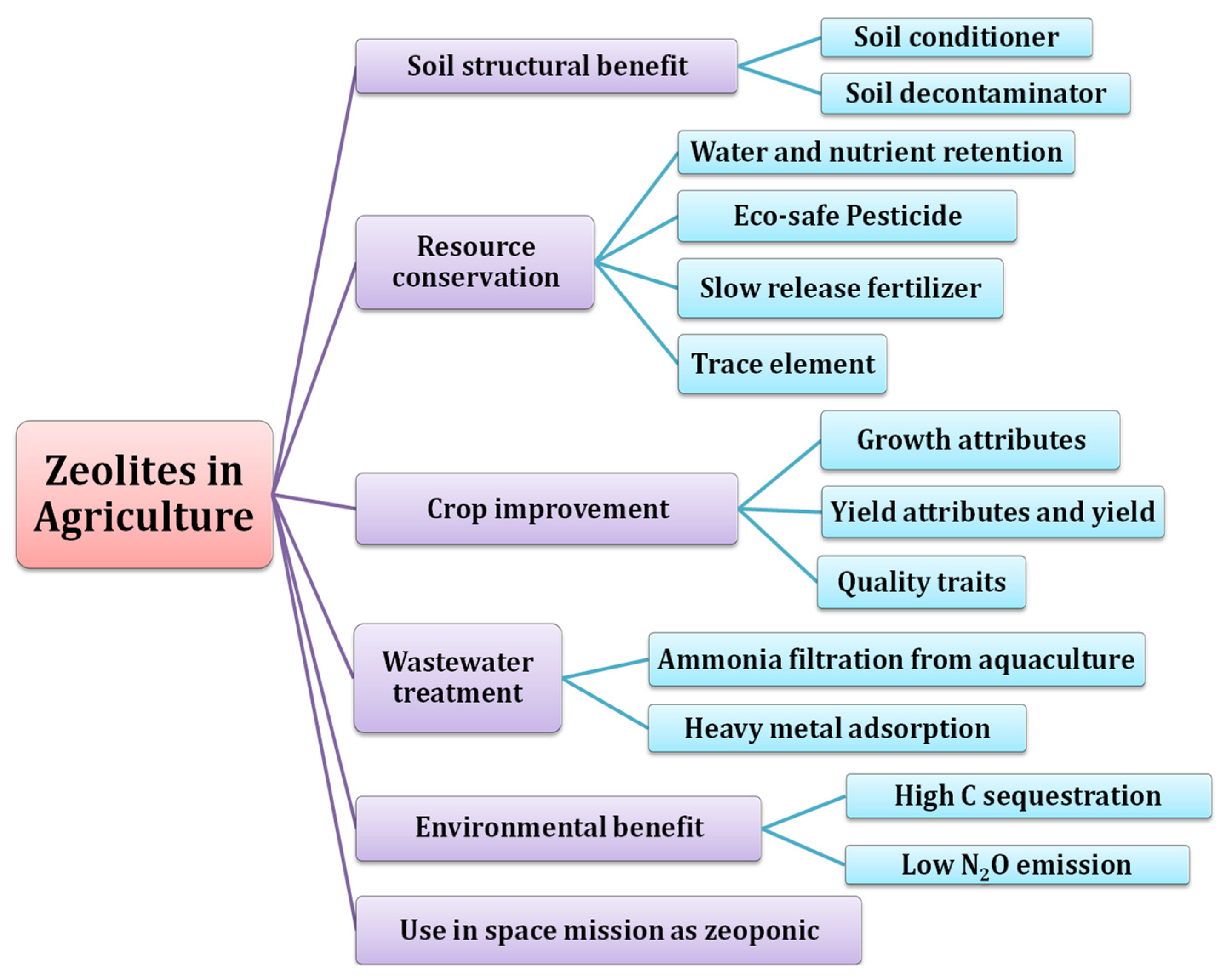
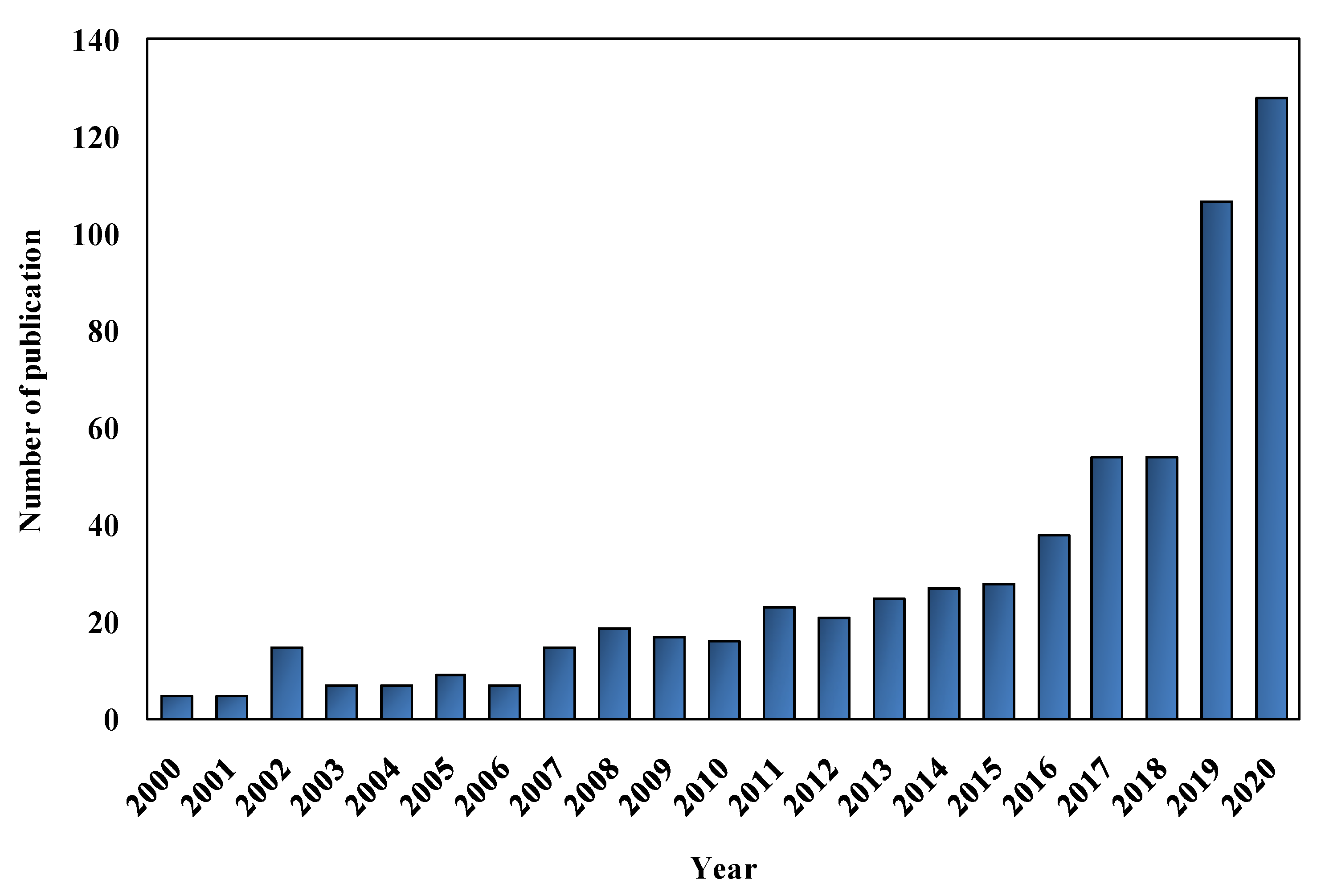
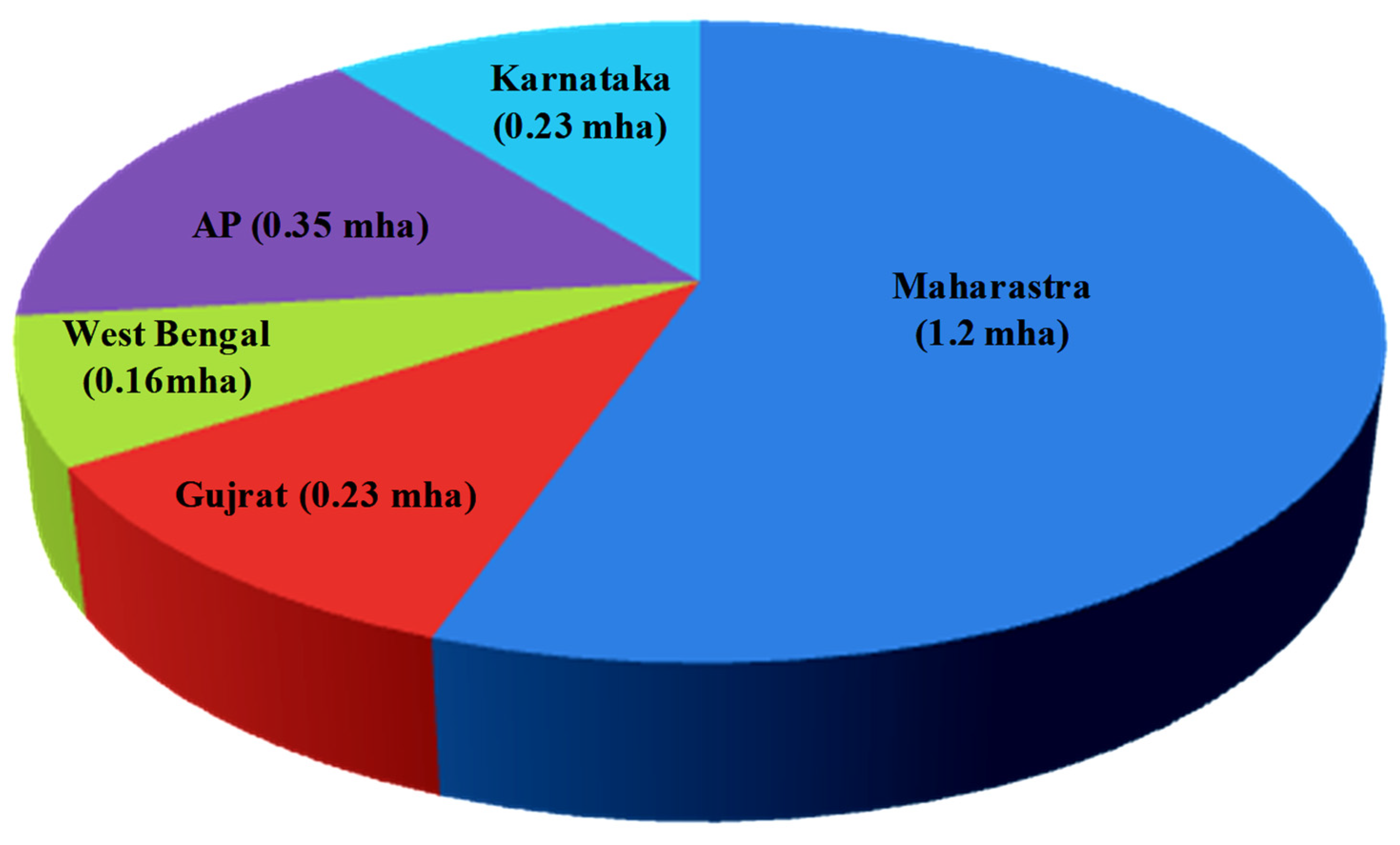
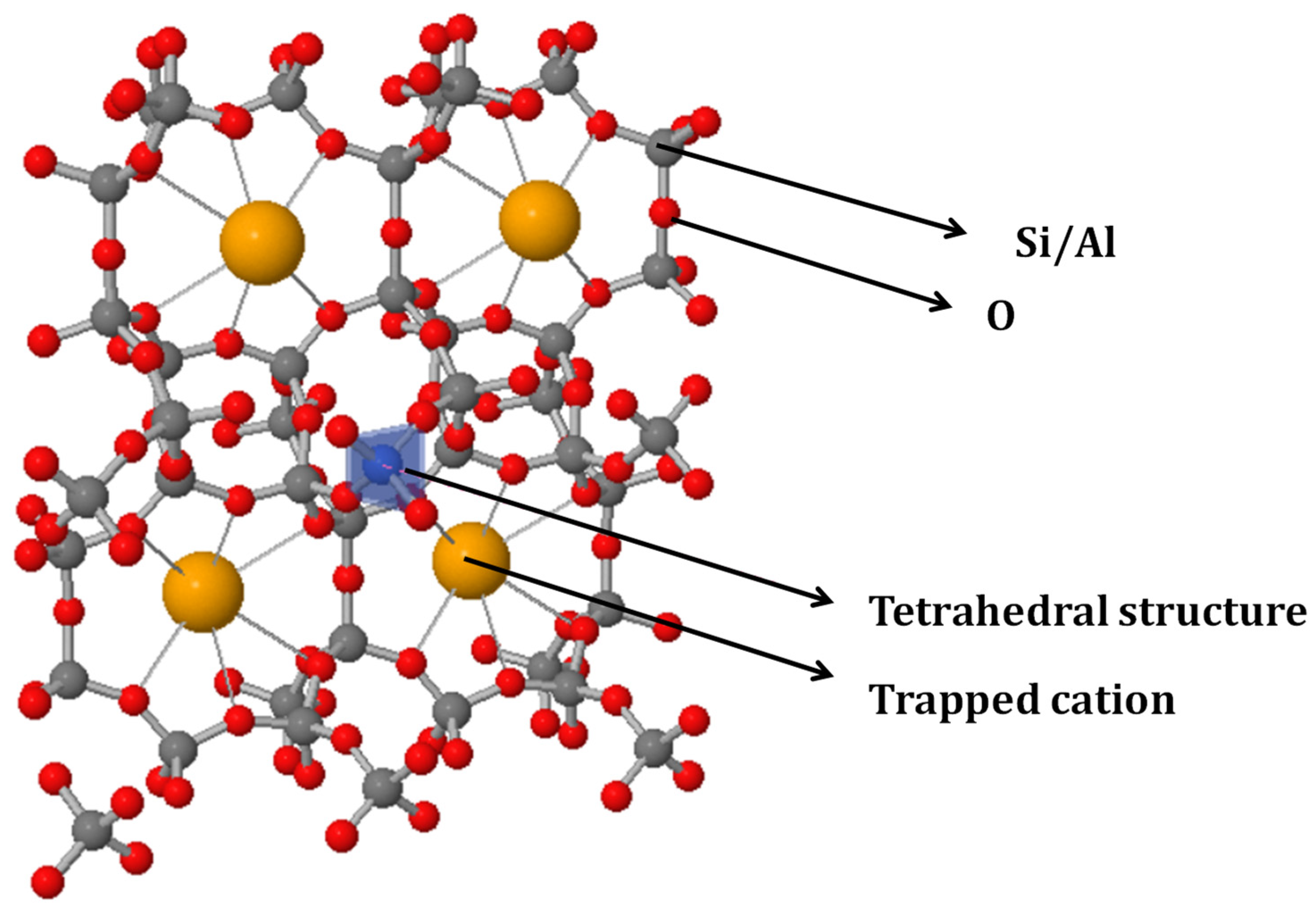
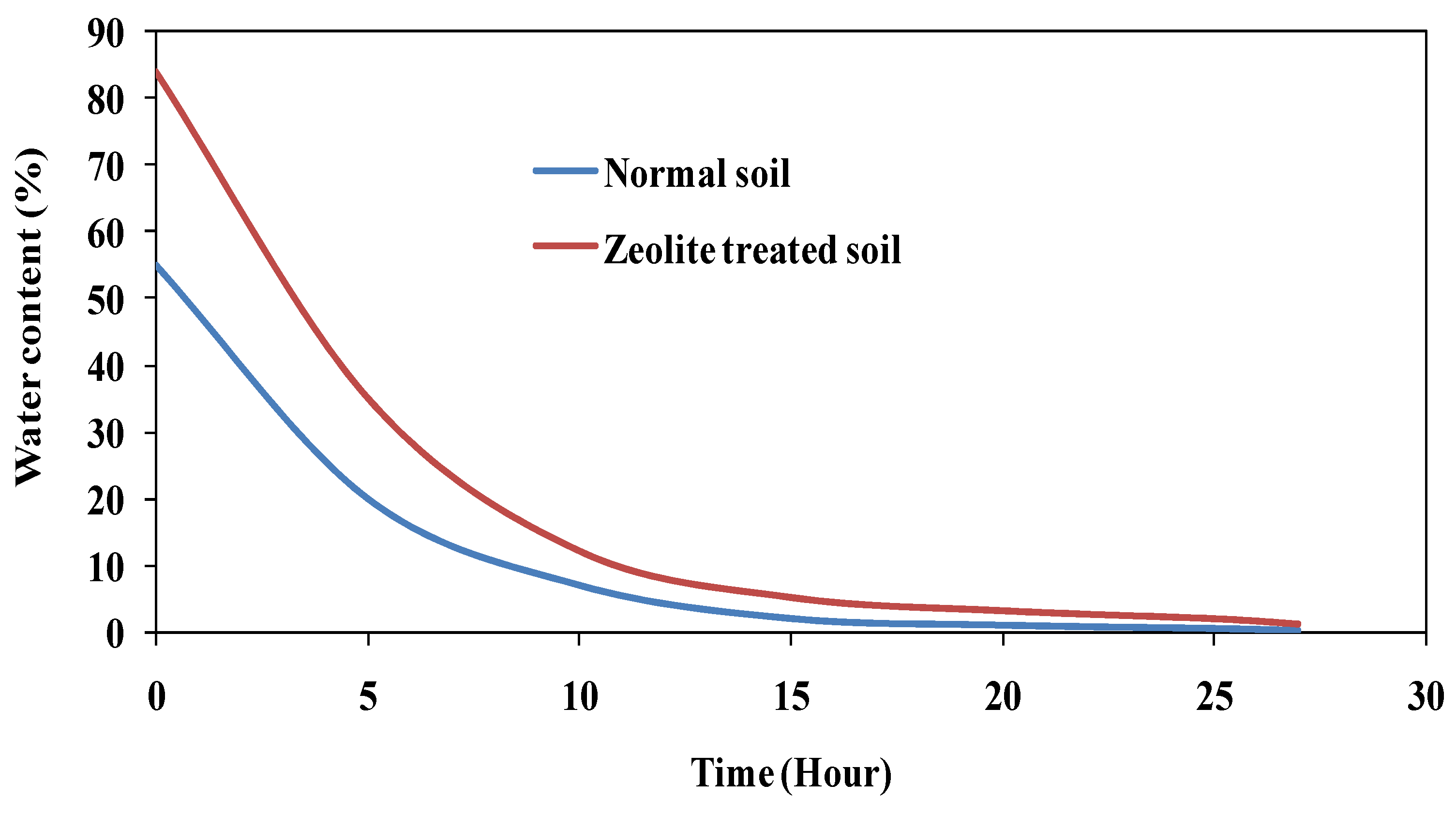
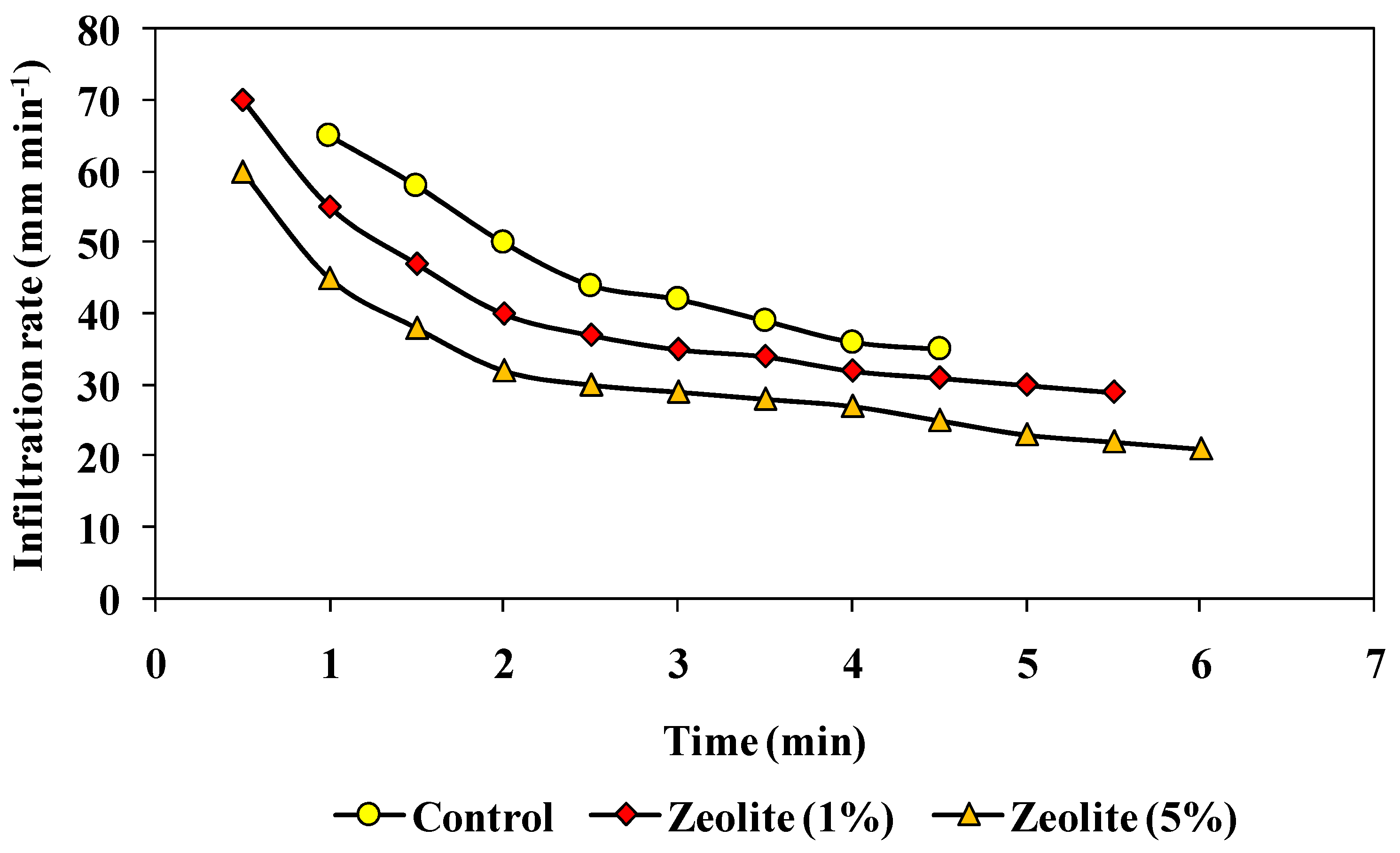
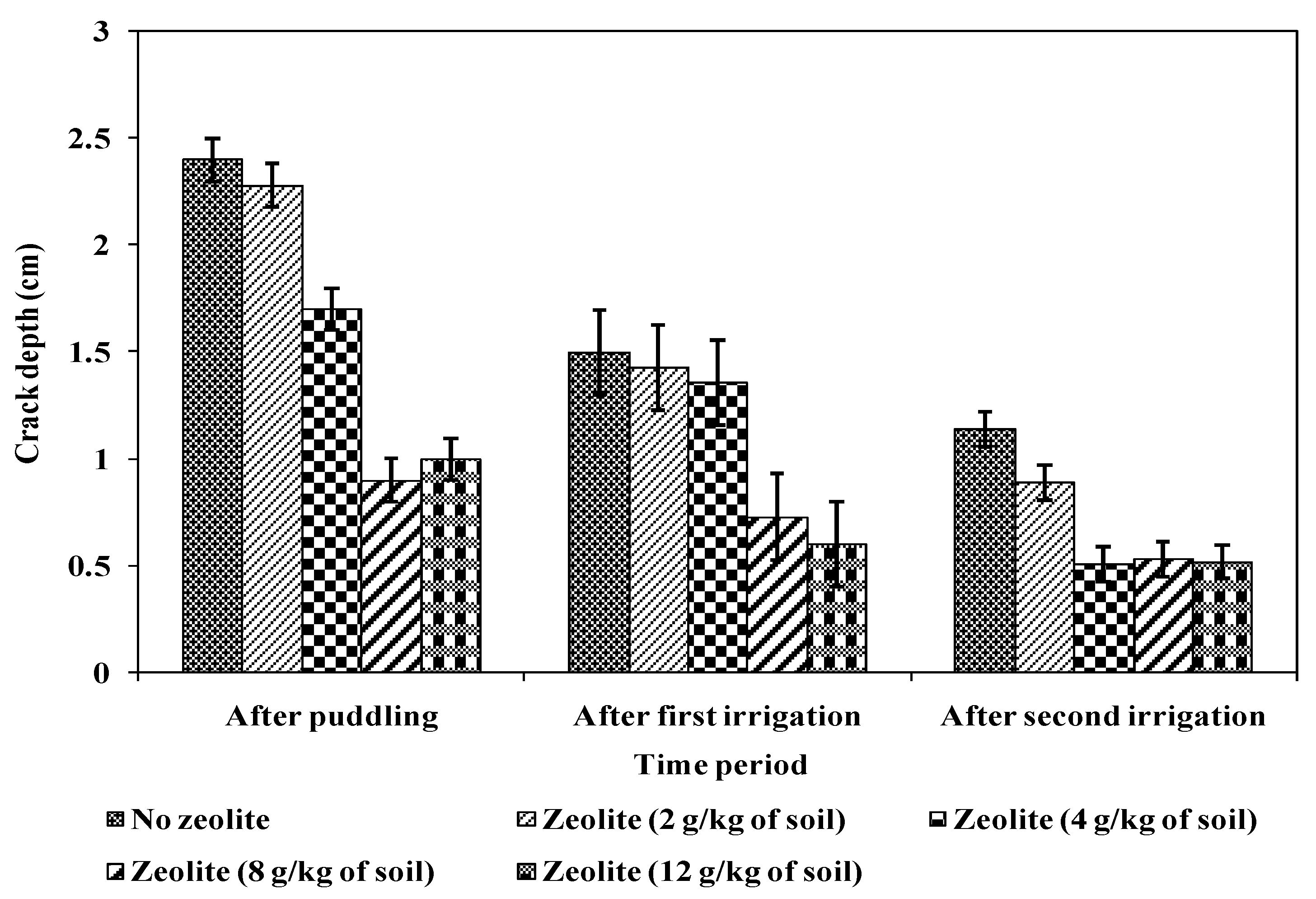

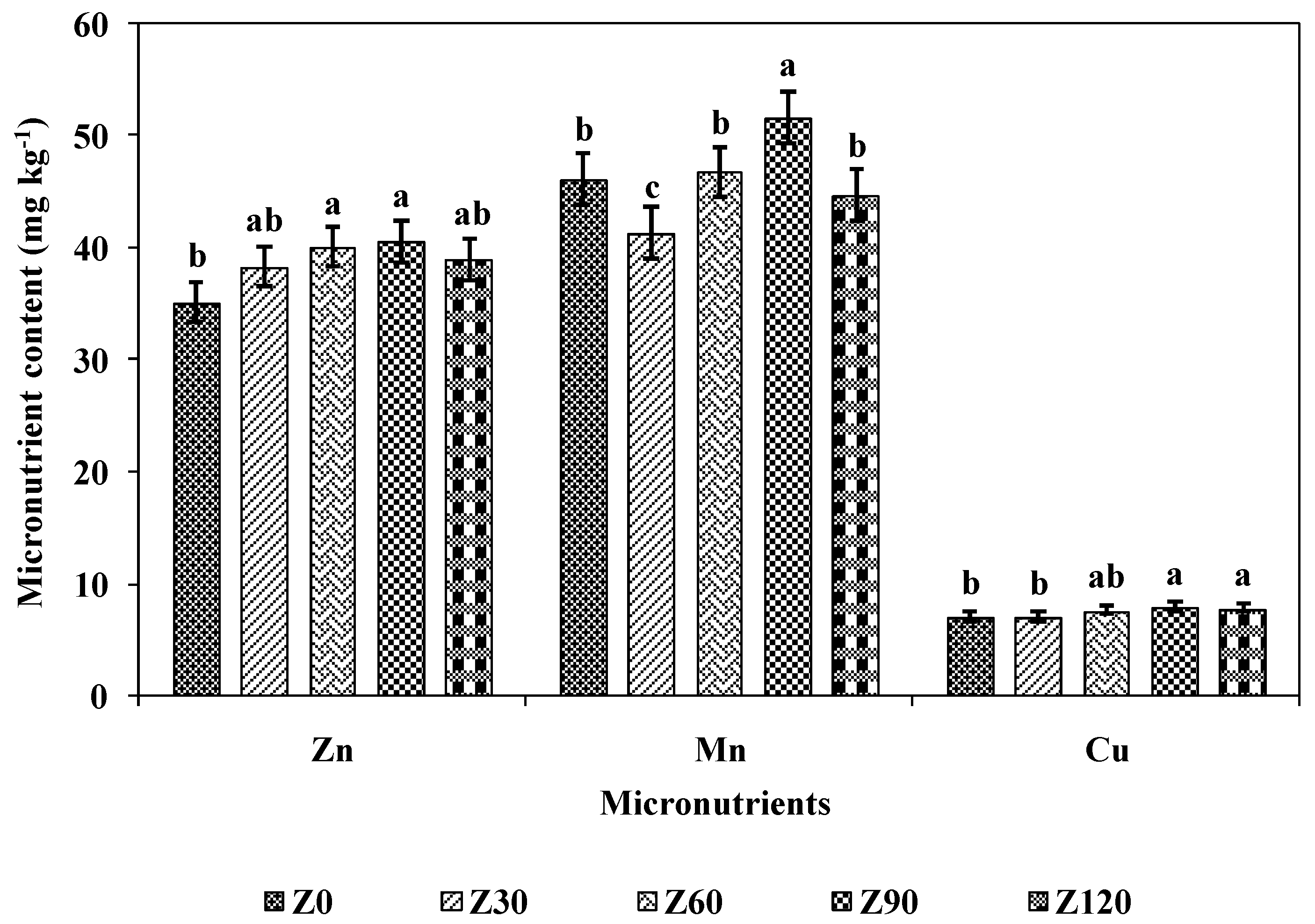
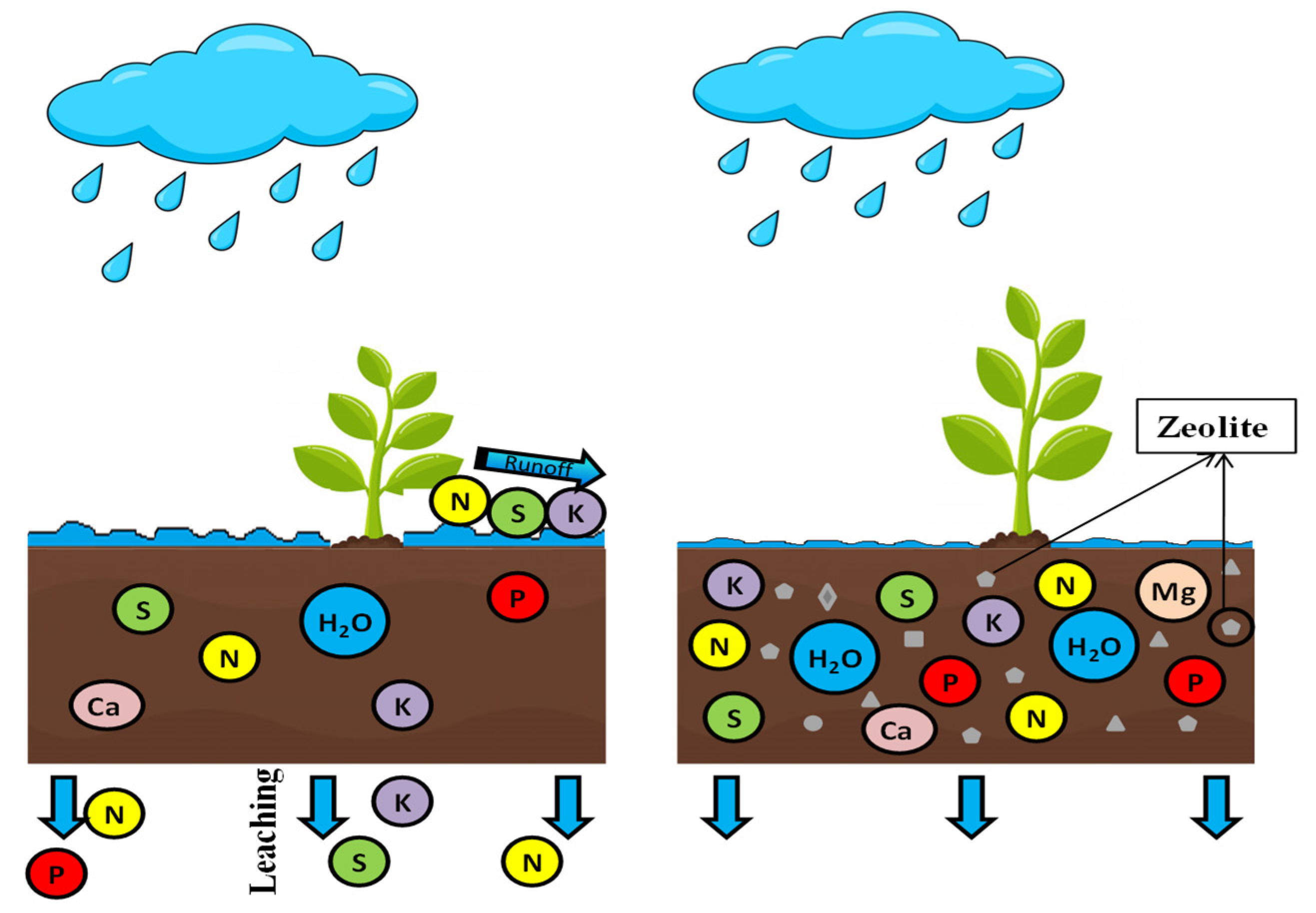
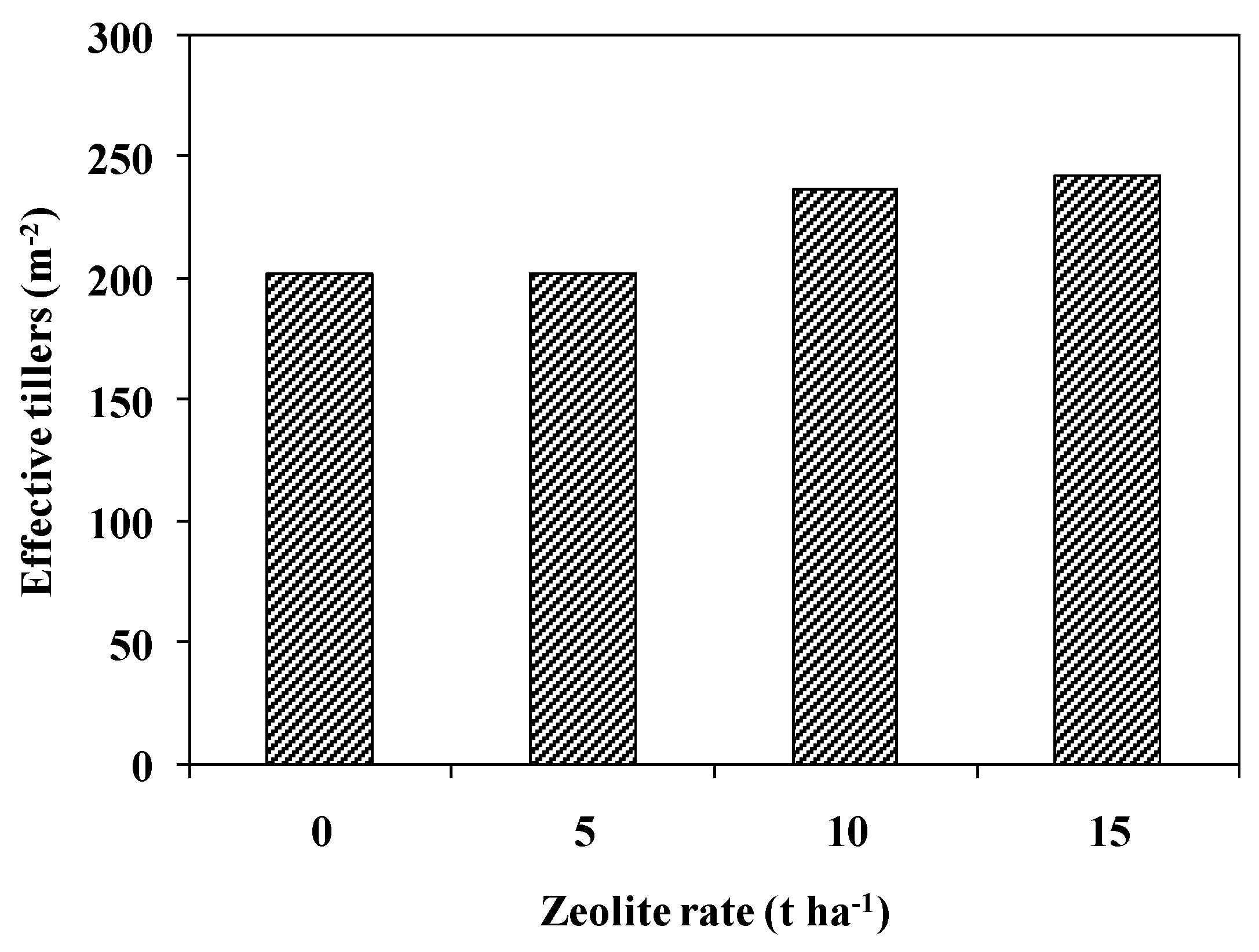
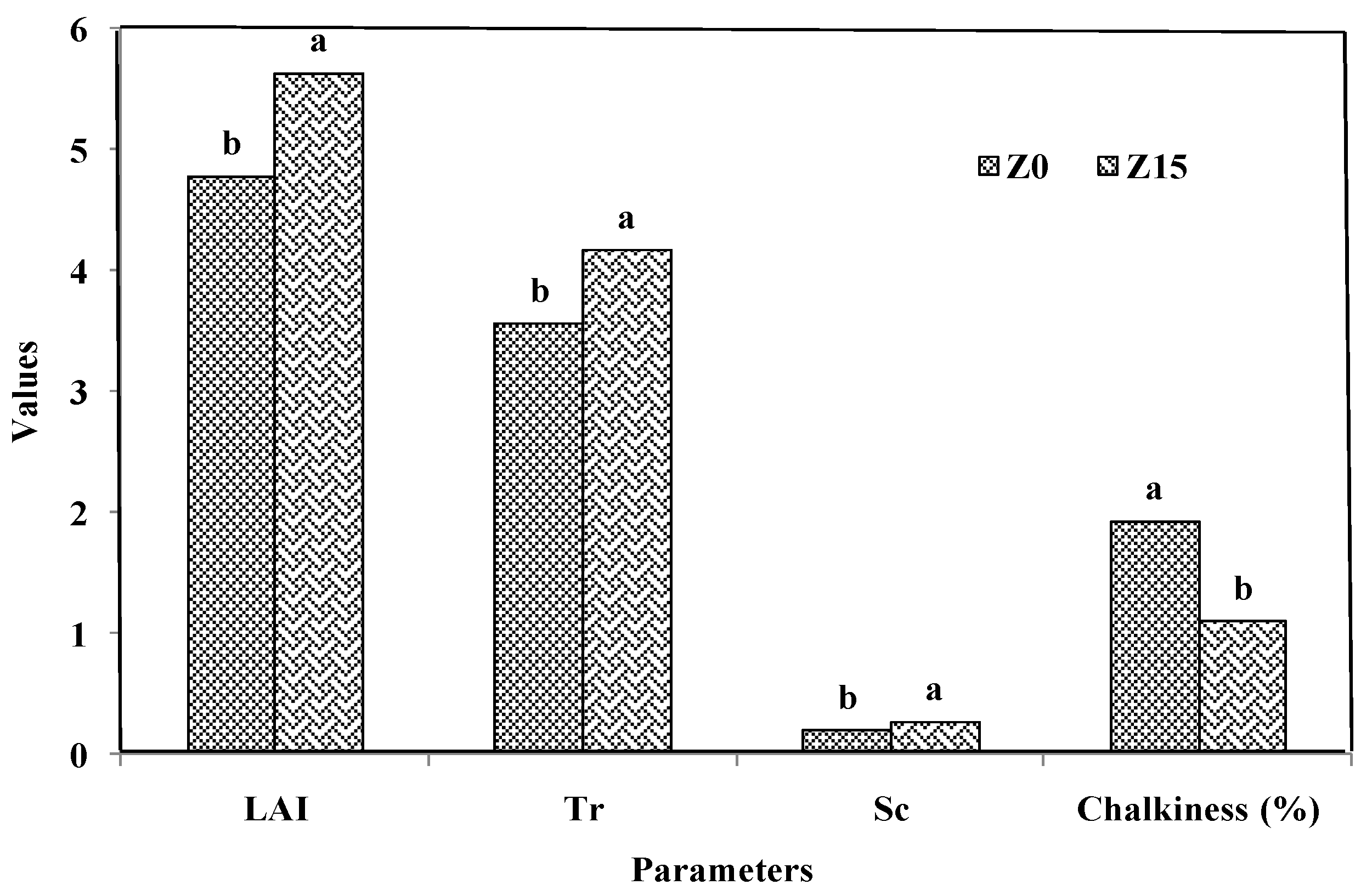

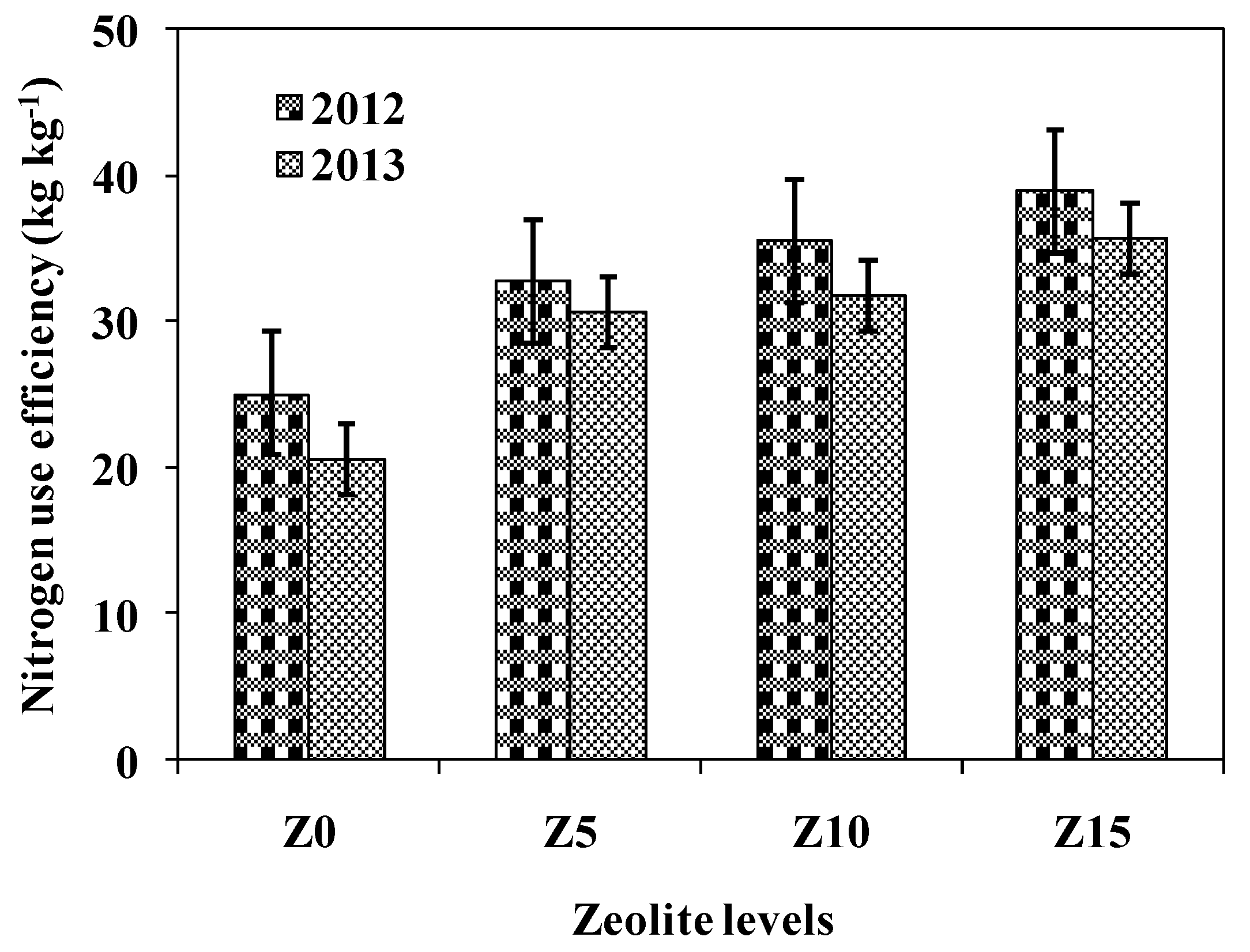
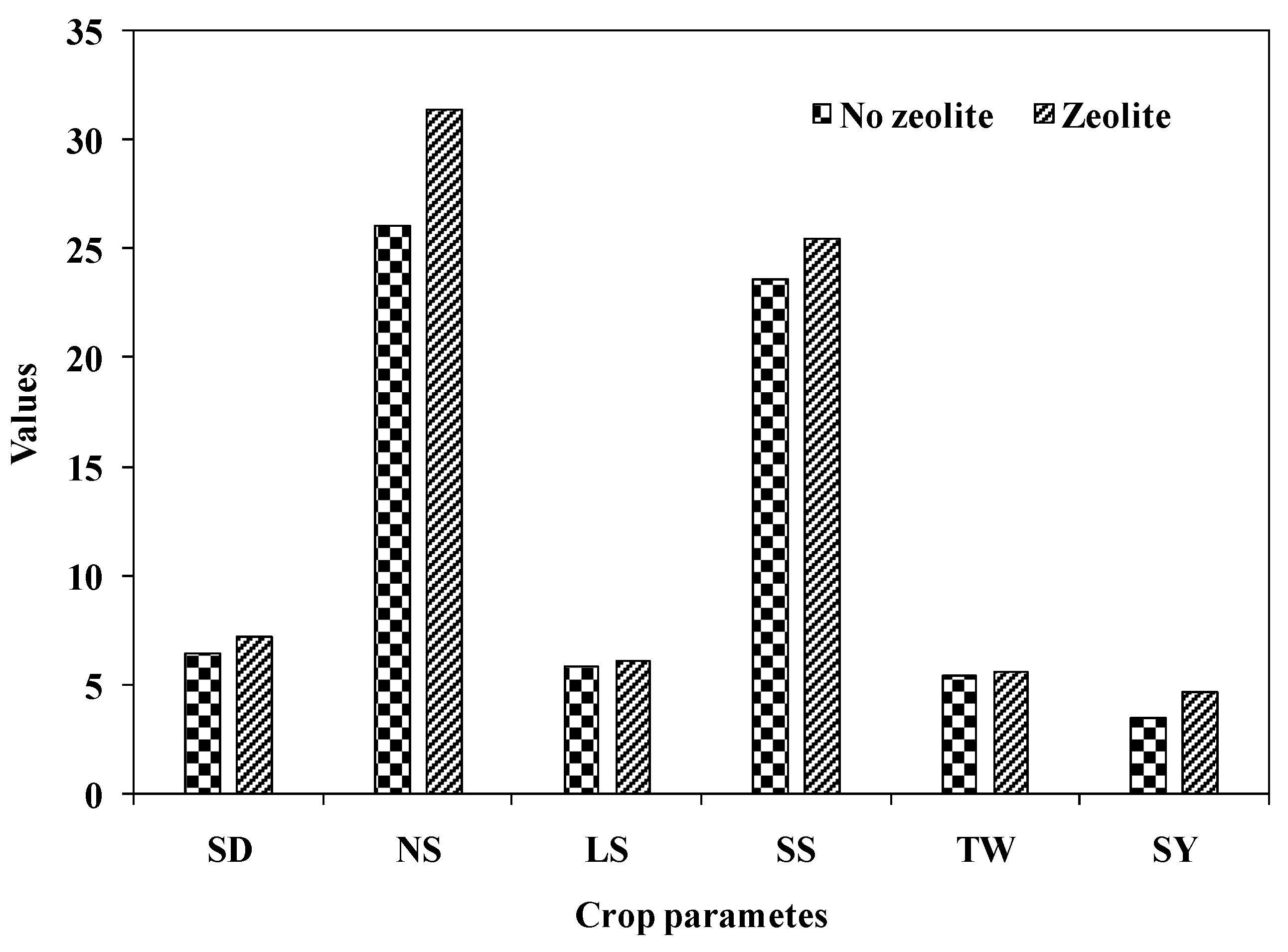
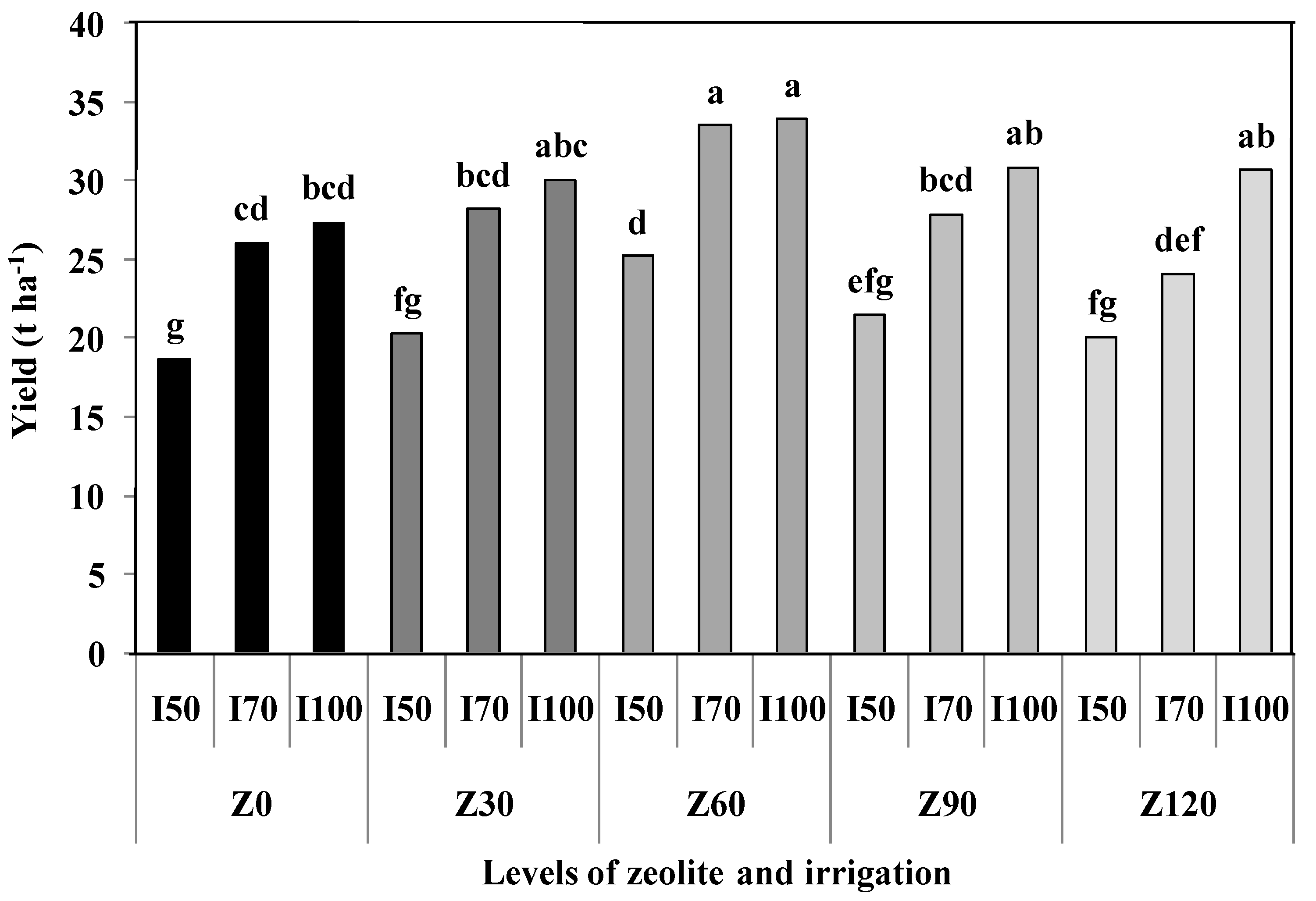
| Zeolites | Porosity (%) | Channel Dimensions (Å) | Heat Stability | Ion Exchange Capacity (meq g−1) | Specific Gravity (g cm−3) | Bulk Density (g cm−3) | References |
|---|---|---|---|---|---|---|---|
| Analcine Na10(Al16Si32O96)·16H2O | 18 | 2.6 | High | 4.55 | 2.24–2.29 | 1.85 | Sangeetha and Baskar [42] |
| Chabezite(Na2Ca)6(Al12Si24O72)·40H2O | 47 | 3.7 × 4.2 | High | 3.85 | 2.50–2.10 | 1.45 | IZA [43] |
| Clinoptilolite (Na3K3)(Al6Si30O72)·24H2O | 34 | 3.9 × 5.4 | High | 2.17 | 2.15–2.25 | 1.15 | IZA [43] |
| Erionite (AlCaH60KNaO36Si2+3) | 35 | - | High | 3.12 | 2.02–2.08 | 1.51 | Hemingway and Robie [44] |
| Heulandite (Ca4)(Al8Si28O72)·24H2O | 39 | 4.0 × 5.5 | Low | 2.90 | 2.18–2.20 | 1.69 | Sangeetha and Baskar [42] |
| Mordenite(Na8)(Al8Si40O96)·24H2O | 28 | 2.9 × 5.7 | High | 4.30 | 2.12–2.15 | 1.70 | Chmielewska and Lensỳ [45] |
| Philipsite(NaK)5(Al5Si11O32)·20H2O | 31 | 4.2 × 4.4 | Moderate | 3.32 | 2.15–2.20 | 1.58 | Chmielewska and Lensỳ [45] |
| Faujasite (Na58)(Al58Si134O384)·240H2O | 47 | 7.4 | High | 3.38 | - | - | Hemingway and Robie [44] |
| Laumonitte(Ca4)(Al8Si16O48)·16H2O | 34 | 4.6 × 6.3 | Low | 4.25 | - | - | Sangeetha and Baskar [42] |
| Linde A(Na12)(Al12Si12O48)·27H2O | 47 | 4.4 | High | 5.47 | - | - | Sangeetha and Baskar [42] |
| Linde X(Na86)(Al86Si106O384)·264H2O | 50 | 7.4 | High | 4.72 | - | - | Sangeetha and Baskar [42] |
| Types of Zeolite | Application Rate (ww−1) | Soil Textural Classes | Changes in Soil Physical Properties | |||
|---|---|---|---|---|---|---|
| Water Content | Infiltration Rate | Hydraulic Conductivity | References | |||
| Clinoptilolite | 1–15% | Clay, loamy sand, sand |
|
|
| Mahabadi et al. [15] |
| Mordenite | – | Calcareous loess |
|
| – | Xiubin and Zhanbin [3] |
| Non-specified natural zeolite | 0.4%, 0.8%, 1.6% and no zeolitie | Sandy loam | – |
|
| Gholizadeh-Sarabi and Sepaskhah [60] |
| Loam | – |
|
| |||
| Clay loam | – |
|
| |||
| Synthetic zeolite (Ca2+-type) | 1% and 5% | Sand dune soil |
|
| Al-Busaidi et al. [16] | |
| Stilbite | 3.33, 6.67, and 10% | Sandy soil |
| – | Bernardi et al. [54] | |
| Clinolite and Ecolite | 15.85% | – | – | – |
| Githinji et al. [62] |
| Soil Type | Zeolite Application Rate | Source of N | N Dose (kg h−1) | Leaching Reduction | References | |
|---|---|---|---|---|---|---|
| NH4+ | NO3− | |||||
| Sand-based putting green | 10% | Ammonium Sulphate | 293 | 99% | 86% | Huang and Petrovic [87] |
| Sandy soil | 0.8% | Ammonium Sulphate | 32 | >90% | – | Zwingmann et al. [88] |
| Loamy sand | 5% | Ammonium Sulphate | 200 † | 83% | – | Mackown and Tucker [89] |
| Sandy loam | 9 * | Urea | 270 | – | 36% | Golamhoseini et al. [90] |
| Silty loam | 4% | Wastewater | 14.2 ‡ | – | 54.9% | Taheri-Sodejani et al. [91] |
| Tested Crop | Type of the NZ | Affecting Insects | Reference |
|---|---|---|---|
| Rice | Minazel plus | Oryzaephilus mercator | Eroglu et al. [191] |
| Wheat | Rhyzopertha dominica | Kljajic et al. [192] | |
| Sitophilus oryzae | |||
| Tribolium castaneum | |||
| Maize | Sitophilus zeamais | Haryadi et al. [181] | |
| Sitophilus oryzae | |||
| Chickpea | Lasioderma serricorne | Perez et al. [193] | |
| Oilseed (Rapeseed) | Klinofeed (dust) | Meligethes sp. | Daniel et al. [182] |
Publisher’s Note: MDPI stays neutral with regard to jurisdictional claims in published maps and institutional affiliations. |
© 2021 by the authors. Licensee MDPI, Basel, Switzerland. This article is an open access article distributed under the terms and conditions of the Creative Commons Attribution (CC BY) license (http://creativecommons.org/licenses/by/4.0/).
Share and Cite
Mondal, M.; Biswas, B.; Garai, S.; Sarkar, S.; Banerjee, H.; Brahmachari, K.; Bandyopadhyay, P.K.; Maitra, S.; Brestic, M.; Skalicky, M.; et al. Zeolites Enhance Soil Health, Crop Productivity and Environmental Safety. Agronomy 2021, 11, 448. https://doi.org/10.3390/agronomy11030448
Mondal M, Biswas B, Garai S, Sarkar S, Banerjee H, Brahmachari K, Bandyopadhyay PK, Maitra S, Brestic M, Skalicky M, et al. Zeolites Enhance Soil Health, Crop Productivity and Environmental Safety. Agronomy. 2021; 11(3):448. https://doi.org/10.3390/agronomy11030448
Chicago/Turabian StyleMondal, Mousumi, Benukar Biswas, Sourav Garai, Sukamal Sarkar, Hirak Banerjee, Koushik Brahmachari, Prasanta Kumar Bandyopadhyay, Sagar Maitra, Marian Brestic, Milan Skalicky, and et al. 2021. "Zeolites Enhance Soil Health, Crop Productivity and Environmental Safety" Agronomy 11, no. 3: 448. https://doi.org/10.3390/agronomy11030448
APA StyleMondal, M., Biswas, B., Garai, S., Sarkar, S., Banerjee, H., Brahmachari, K., Bandyopadhyay, P. K., Maitra, S., Brestic, M., Skalicky, M., Ondrisik, P., & Hossain, A. (2021). Zeolites Enhance Soil Health, Crop Productivity and Environmental Safety. Agronomy, 11(3), 448. https://doi.org/10.3390/agronomy11030448













